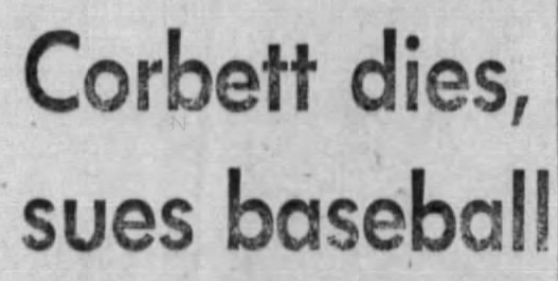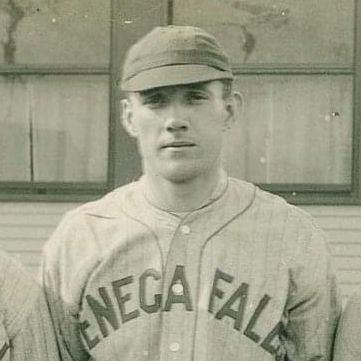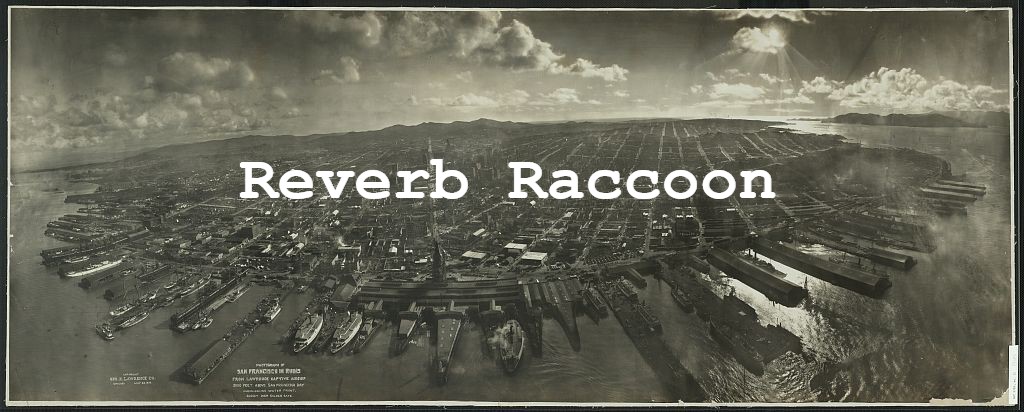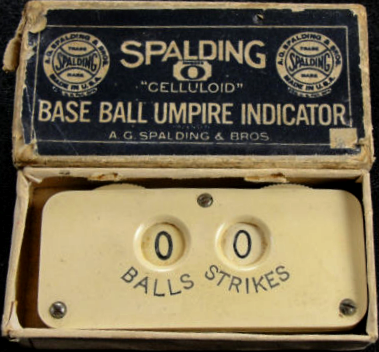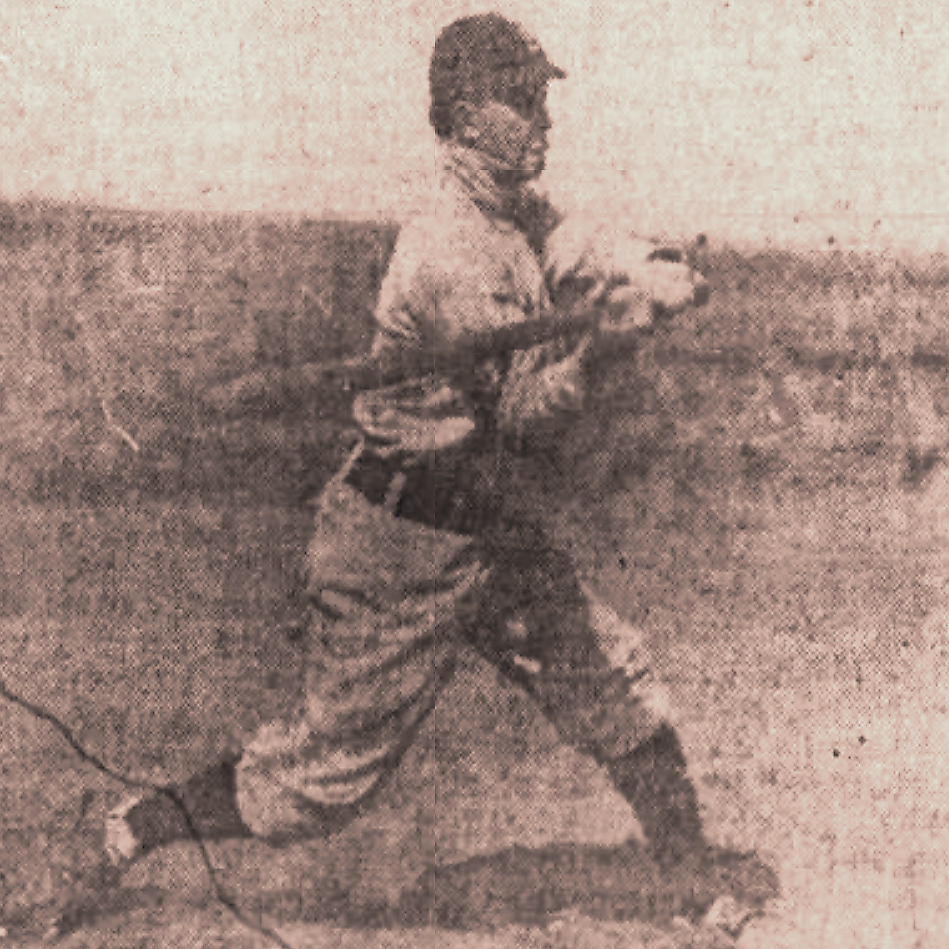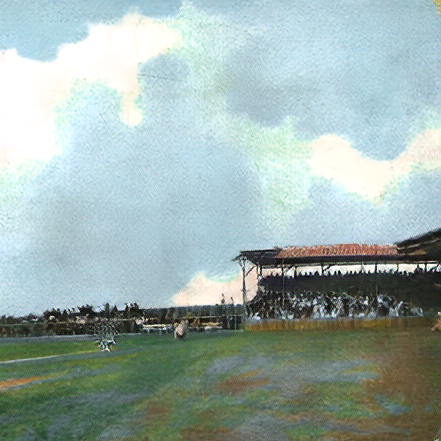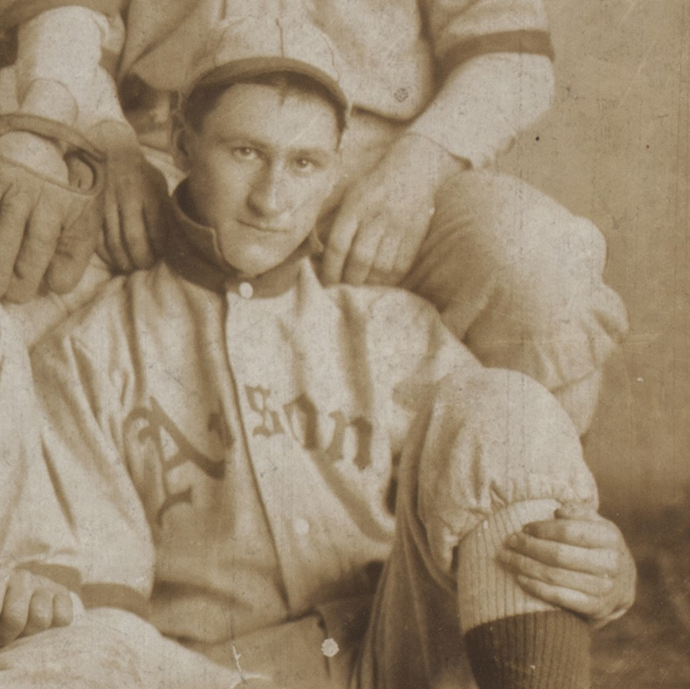The Semi-Pro: The Baseball Life of Walter Ancker (Chapter Two)
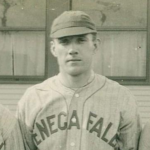 Chapter 1:
Chapter 1:
The Kid Flinger (1915)
Chapter 2:
Look Homeward, Angel (1916)
—-
The names of five students in the Connie Mack School of Baseball Knowledge were erased from the rolls of the Athletics. The quintet disposed of and their new places of abode are: Pitcher Wilbur Davis, to Atlanta, of the Southern league; Pitcher Walter Ancker, to Asheville, of the North Carolina league; Pitcher Harry Eccles, to the Wheeling Central league team; Third Baseman Harry Damrau, to the Raleigh North Carolina league team, and Shortstop Harry C. Seibold, to the Wheeling Central league team. — Pittsburgh Press, February 28, 1916
Mr. Mack has no doubt informed you before this that you have been purchased by this club on an optional agreement. We will report here on the first of April and I will forward you transportation or you can pay your own and it will be refunded upon arrival. We allow Pullman and meals enroute in addition to transportation. Would like to hear from you in regard to this date for reporting and any advice as to the transportation requirements you may have, if these are not satisfactory. — Letter from Jack Corbett (Asheville, North Carolina) to Walter Ancker (Closter, New Jersey), March 7, 1916
And like a man who is perishing in the polar night, he thought of the rich meadows of his youth: the corn, the plum tree, and ripe grain. Why here? O lost! — from Look Homeward, Angel by Thomas Wolfe
Southern Railway train No. 15 was closing on the Asheville depot. Walter Ancker, sitting in the green-cushioned seat of a Pullman car, watched the town envelop the tracks with the relief of one who has been traveling for thirty hours and the anxiety of one who has never traveled so far from home. Home was Closter, New Jersey, a hamlet about ten miles northeast of Hackensack in Bergen County. There, Ancker had been the best semi-pro pitcher in the area. Here, he was the new pitcher for the Asheville Tourists, a team in the North Carolina League.
The Tourists were a Class D minor league team, the worst form of baseball one could play and still claim the title of Professional Ballplayer. There were seven rungs on the professional baseball ladder: Major League, Triple-A, Double-A, Single-A, B, C, and D. The lowest rung was D, and that’s where Walter Ancker was. He’d had a quick cup of coffee on the top rung the previous year when he appeared in four games with Connie Mack’s Philadelphia Athletics. Ancker had shown flashes of competence, but Connie Mack thought he needed more experience before he was ready for another trip to the majors. Ancker needed to tame the wildness that had resulted in a litany of walks, plus a few hit batters and assorted wild pitches. He had perpetually pitched with the bases loaded.
Ancker, two weeks shy of his twenty-third birthday, had departed Closter on Tuesday morning, March 28, 1916. It was difficult to leave. His father had died five years before, and he and his three brothers all worked to support their mother and themselves. Walter’s professional baseball career was about to make a significant dent in the family’s finances. The Tourists would pay Ancker $100 each month. He could make more than that in Closter, playing semi-pro ball and working as an electrician. Ancker promised his brothers that he would come home, and not try to catch on with a semi-pro team in North Carolina, if things didn’t work out in Asheville.
The 107-mile trip from Closter to North Philadelphia Station had taken hours, as the commuter train stopped at every berg and village in the Passaic Valley. Ancker met Earle Mack, Connie Mack’s son and his new teammate on the Tourists, in the North Philly concourse. Mack and Ancker recognized each other readily: they both carried a suitcase and a long cloth bag containing the tools of their trade. Ancker’s bag held a bat, a fielder’s glove, his metal-cleated baseball shoes, a couple of well-worn balls, a cap, and a set of old flannels. Mack’s bag held the same equipment, plus a catcher’s mitt and a first baseman’s glove. Ancker noted that, while his suitcase and Mack’s were equally battered, Mack’s had begun its life as a finer item of luggage.
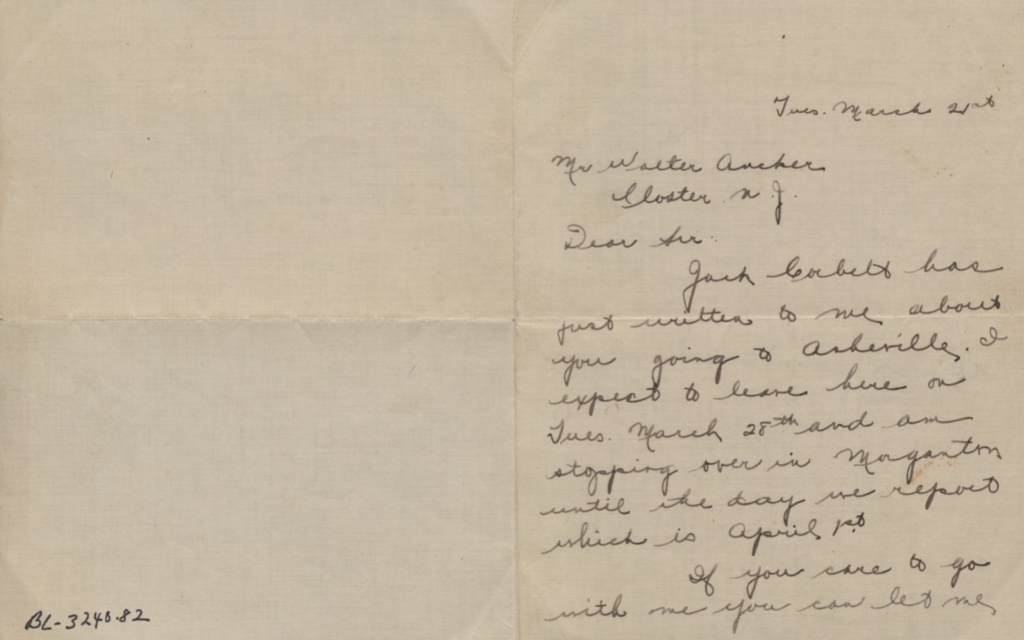 Page 1 of a letter from Earle Mack (Philadelphia, Pennsylvania) to Walter Ancker (Closter, New Jersey) written March 21, 1916. From the National Baseball Hall of Fame. Text of page: Jack Corbett has just written to me about you going to Asheville. I expect to leave here on Tues. March 28th and am stopping over in Morganton until the day we report which is April 1st. If you care to go with me you can let me…
Page 1 of a letter from Earle Mack (Philadelphia, Pennsylvania) to Walter Ancker (Closter, New Jersey) written March 21, 1916. From the National Baseball Hall of Fame. Text of page: Jack Corbett has just written to me about you going to Asheville. I expect to leave here on Tues. March 28th and am stopping over in Morganton until the day we report which is April 1st. If you care to go with me you can let me…
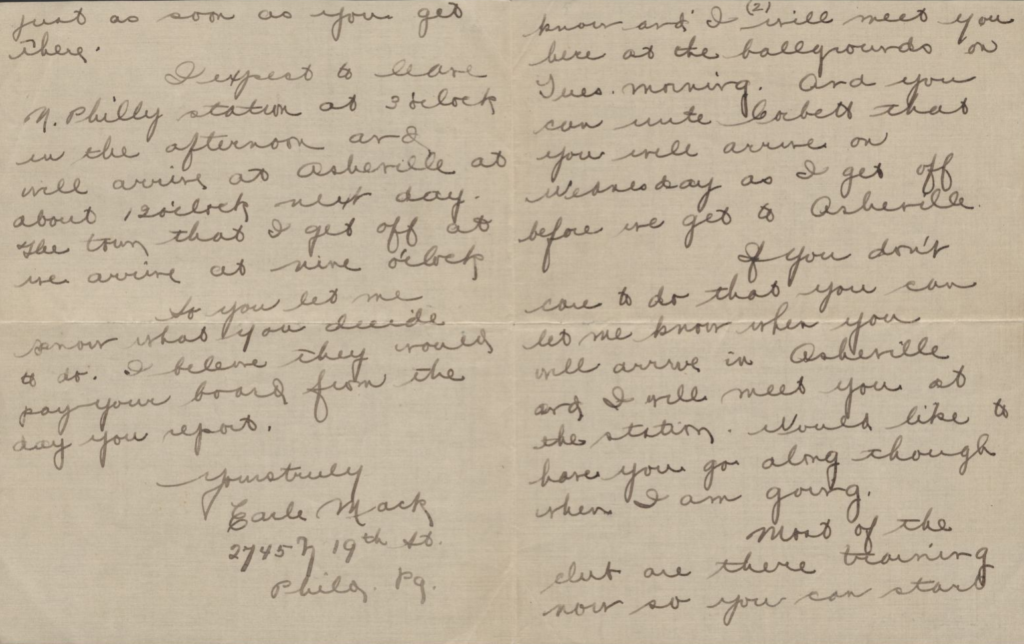 Pages 2 (right) and 3 (left) of the letter from Earle Mack to Walter Ancker. Mack suggests that they meet ‘here at the ballgrounds.’ But if Ancker took the train from Closter, they probably met at North Philly station. From the National Baseball Hall of Fame. Text of pages: …know and I will meet you here at the ballgrounds on Tues. morning. And you can write Corbett that you will arrive on Wednesday as I get off before we get to Asheville. If you don’t care to do that you can let me know when you will arrive in Asheville and I will meet you at the station. Would like to have you go along though when I am going. Most of the club are there training now so you can start just as soon as you get there. I expect to leave N. Philly station at 3 o’clock in the afternoon and will arrive at Asheville at about 12 o’clock next day. The town that I get off at we arrive at nine o’clock. So let me know what you decide to do. I believe they would pay your room and board from the day you report.
Pages 2 (right) and 3 (left) of the letter from Earle Mack to Walter Ancker. Mack suggests that they meet ‘here at the ballgrounds.’ But if Ancker took the train from Closter, they probably met at North Philly station. From the National Baseball Hall of Fame. Text of pages: …know and I will meet you here at the ballgrounds on Tues. morning. And you can write Corbett that you will arrive on Wednesday as I get off before we get to Asheville. If you don’t care to do that you can let me know when you will arrive in Asheville and I will meet you at the station. Would like to have you go along though when I am going. Most of the club are there training now so you can start just as soon as you get there. I expect to leave N. Philly station at 3 o’clock in the afternoon and will arrive at Asheville at about 12 o’clock next day. The town that I get off at we arrive at nine o’clock. So let me know what you decide to do. I believe they would pay your room and board from the day you report.
Earle Mack — legally Earle Thaddeus McGillicuddy — had been contacted by Jack Corbett, the player-manager of the Asheville Tourists, regarding Ancker’s journey to Asheville. Mack was coming down from Philadelphia, and Corbett wanted Ancker to accompany him. Mack was an old hand at making the trip from Philly to North Carolina. For the past three seasons he had been the player-manager for the Raleigh Capitals, another team in the North Carolina League. He had signed with Asheville to be closer to the family of his new wife, the former Mary Margaret Cain, who lived 60 miles up the Southern Railway tracks in Morganton. The Cains, even with their solid Scotch-Irish roots, must have thought twice about their daughter now being Mary Margaret McGillicuddy.
Ancker was grateful to have Mack along as a guide. He could handle the spider web of commuter lines that enmeshed northern New Jersey. But entering a Pullman car was like stepping up from the flat surface of the Hackensack semi-pro diamond to the major league mound of Shibe Park.
The two ballplayers left North Philly station at 3 PM, riding the Southern rails aboard car K-19. They crossed the Mason-Dixon Line beyond Wilmington, and Ancker entered the South for the first time. As the train rattled out of Washington Union Station, Walter saw the Capital just west of the tracks and the Washington Monument silhouetted against the setting sun. He thought about his father, born in Germany, and about his mother, born in America but as German as they came. And he thought about the Senators, eight of whom he had walked back in September in his only major league start.
Somewhere in the Virginia gloaming, Ancker and Mack moved to the club car for a drink while the porter made up their beds, converting their cushioned seats into the lower berth and opening the trap door in the long compartment above the windows where the upper berth lay hidden. Earle Mack must have known their porter from a previous trip because he knew his name: George.
The players returned from the club car, and Mack slid effortlessly between the curtains of the lower berth. Ancker’s situation was more problematic. The rickety ladder that George held in position bowed as Ancker hauled his 190 pounds into the upper berth. Mr. Pullman had not designed the bed with the idea of accommodating a six-foot-one-inch ballplayer, and Ancker had to roll onto his side and pull up his legs to fit. After George closed and tied the curtains, there was the matter of undressing, which in the cramped space required the flexibility of a circus contortionist. Now Ancker understood the old joke, The price for the upper was lower because it was higher. He couldn’t complain, though; the Asheville Tourists were footing the bill, and Mack’s seniority entitled him to the lower berth.
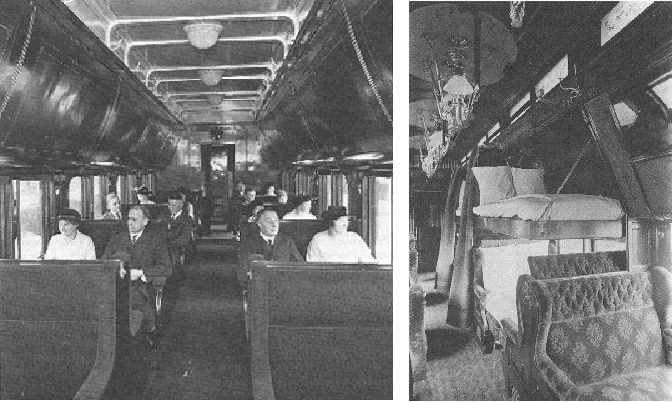 ‘Open section’ Pullman cars. Left: Pullman car configured for daytime travel, 1916. Right: Pullman car configured for sleeping, 1890. The seats converted into lower berths, and the upper berths folded down from the compartments above the windows. From Rails West.
‘Open section’ Pullman cars. Left: Pullman car configured for daytime travel, 1916. Right: Pullman car configured for sleeping, 1890. The seats converted into lower berths, and the upper berths folded down from the compartments above the windows. From Rails West.
Ancker recalled one of sportswriter Timothy Murnane’s rules for traveling ballplayers: Don’t continually kick at your luck in drawing an upper berth in a sleeping car. Ancker tried reading a newspaper that someone had abandoned in the club car. General Pershing had chased Pancho Villa into the foothills of the Sierra Madre, and the talk in Washington was of ending diplomatic relations with Germany. But he soon gave it up and extinguished the dim bulb near his head. Murnane had another rule for the situation: Don’t read small print by artificial light, or print of any kind while traveling in the cars.
Ancker fell asleep listening to the rhythmic rumble that would ease Southern Railway passengers into slumber for another half-century.
Now, as the train skirted the southern edge of Asheville and turned north into the valley of the French Broad River, Ancker had the two facing seats to himself. Mack had exited the train that morning at Morganton, planning to spend a couple of days with the Cains before joining the Tourists on April 1. At 11:59 AM, the locomotive slowed, the air brakes hissed, and the couplings clanked as the cars compressed together. A beautiful stucco building appeared on the right side of the train.
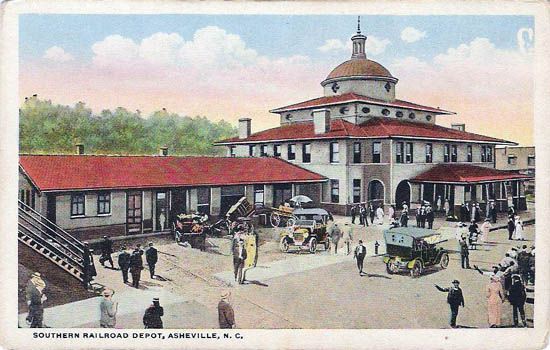 Southern Railway Depot, Asheville, North Carolina. The depot opened in 1906.
Southern Railway Depot, Asheville, North Carolina. The depot opened in 1906.
Ancker stepped down from the car and instinctively clutched the collar of his overcoat. It had been raining and 34 degrees when he left New Jersey. Thirty hours and 700 miles farther south, the temperature was still barely above 40. He looked around for someone who might be Jack Corbett. Instead, a kid, maybe 15 years old, stepped forward and said, ‘Mr. Ancker? Welcome to the Land of the Sky.’
The kid introduced himself as Tommy Wolfe, the Tourists’ batboy. Jack Corbett had dispatched him to collect their new pitcher. Tommy retrieved Ancker’s bags and they boarded a streetcar waiting on the tracks in front of the depot. The conductor bell rang the car to life, and it skittered down Depot Street before turning onto South Side Avenue.
 Streetcar in front of the Asheville depot. The sign on the car announces BASE BALL TO-DAY. From Asheville Junction.
Streetcar in front of the Asheville depot. The sign on the car announces BASE BALL TO-DAY. From Asheville Junction.
Ancker glimpsed a slice of a town housing about 25,000 souls. Contrary to what he had been told, most of the inhabitants wore shoes. Tommy said that several players boarded at a house near the ballpark; the club had reserved a bed there for Ancker. Corbett lived in a boarding house operated by Tommy’s mother on Spruce Street. Tommy explained that Corbett was busy, which he said could mean anything from hanging out at the Western Union office to lounging in Mrs. Wolfe’s parlor, entertaining the other guests with tall tales of his life as a ballplayer.
The streetcar braked to a halt and Tommy, then Ancker, stepped off. Tommy walked across the sidewalk and led Ancker through a wooden gate and into what was, apparently, a ballpark. Oates Park was a ramshackle affair of leaning fences, patchy grass, and grandstands that looked like they would fall over in a stiff breeze. It was much worse than Oritani Field in Hackensack. Ancker now fully grasped that he had taken a long slide down from pitching for the Philadelphia Athletics in the concrete-and-steel glory of Shibe Park.
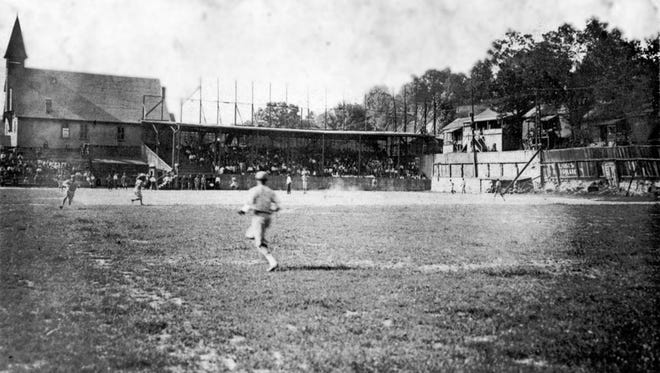 The Royal Giants, Asheville’s first Black semi-pro team, playing in Oates Park around 1916 when the field was only three years old. The umpire (in a white shirt) is standing behind the pitcher’s mound, his usual position when a single official worked the game. The Southside AME Church is behind the first base bleachers, and McDowell Street is behind the third base line. Boys would climb the trees outside the park to watch a game for free. Before 1916, fans were allowed to park their cars inside the park. From the Asheville Citizen-Times.
The Royal Giants, Asheville’s first Black semi-pro team, playing in Oates Park around 1916 when the field was only three years old. The umpire (in a white shirt) is standing behind the pitcher’s mound, his usual position when a single official worked the game. The Southside AME Church is behind the first base bleachers, and McDowell Street is behind the third base line. Boys would climb the trees outside the park to watch a game for free. Before 1916, fans were allowed to park their cars inside the park. From the Asheville Citizen-Times.
Ancker removed his cloth cap, revealing a head of reddish-brown hair, and noted the pitching mound. It was higher than the mounds he pitched from in Bergen County; some of the fields there didn’t have a mound at all. Shibe Park’s foot-high mound had bedeviled him. It messed up all of his angles. He couldn’t get the ball down, and when he tried to force it down, the pitches either hit the dirt or the front of the grandstand. And then there was the problem of his curves not breaking the way they did in Bergen County, hitting the batter instead of the catcher’s mitt. He’d put in some decent innings, just not enough of them. Ancker knew that Connie Mack was right: he needed more experience and he had descended into the baseball basement to find it.
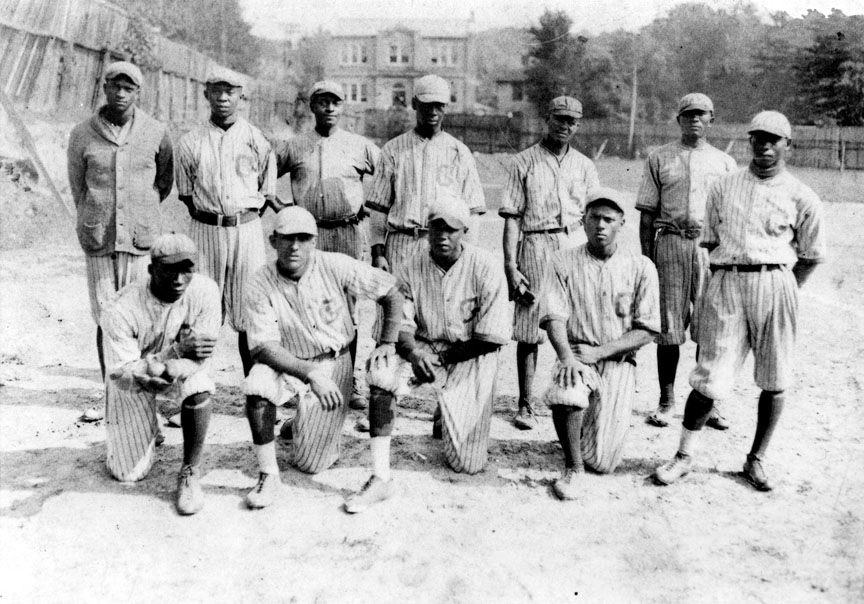 The Asheville Royal Giants posed on the third base side of Oates Park around 1916. Choctaw Street is beyond the outfield fence. From the Asheville Mountain Express.
The Asheville Royal Giants posed on the third base side of Oates Park around 1916. Choctaw Street is beyond the outfield fence. From the Asheville Mountain Express.
‘I thought you might like to see this,’ Tommy said. ‘Is there anything that can evoke spring — the first fine days of April — better than the sound of the ball smacking into the pocket of the big mitt, the sound of the bat as it hits the horse hide? And is there anything that can tell more about an American summer than the smell of the wooden bleachers in a small-town baseball park, that resinous, sultry, and exciting smell of old dry wood? Now if we hurry, we can still catch dinner at the house.’
Tommy turned to exit the ballpark. Ancker followed him, examining the kid with a mixture of curiosity and alarm. Oh Lord, he thought as they passed through the gate. What have I gotten myself into?
And Tommy, having noticed Ancker’s hair, thought about the story he was forming in his mind, the one about the black-haired baseball player who clubs a red-haired rival into submission with his bat.
—-
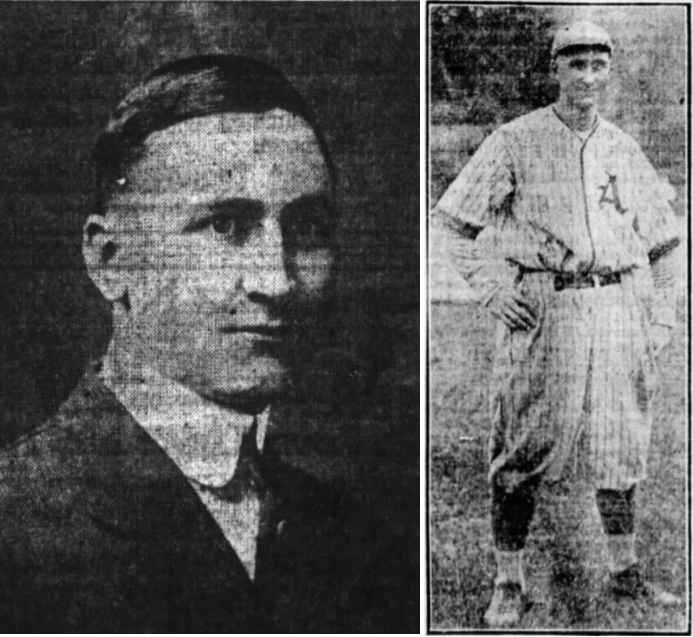 Jack Corbett, from the Asheville Citizen-Times. Formal portrait (left), September 1915. In the uniform of the Asheville Tourists (right), March 1916. Corbett was five feet, nine inches tall, and weighed about 160 pounds. One writer described him as ‘nobby.’
Jack Corbett, from the Asheville Citizen-Times. Formal portrait (left), September 1915. In the uniform of the Asheville Tourists (right), March 1916. Corbett was five feet, nine inches tall, and weighed about 160 pounds. One writer described him as ‘nobby.’
Jack Corbett’s best friend is Jack Corbett; his ideal, Jack Corbett; his criterion, Jack Corbett; and his hero, Jack Corbett. — Winston-Salem Twin-City Daily Sentinel, March 11, 1916
John Philip Corbett was born in Columbus, Ohio, on August 2, 1887. The family moved to Anderson, Indiana, sometime before 1900 when the census caught up with them. ‘Jack’ Corbett’s earliest baseball experiences are undocumented. His obituary stated that he began playing baseball in 1904. A 1914 newspaper article claimed that Corbett ‘piloted an independent ball club several seasons prior to his debut into professional circles.’
The records and newspaper clippings indicate that in 1908, when Corbett was 20 years old, he was playing Class D professional ball. He began that season holding down second base for the Monroe (Louisiana) Municipals of the Cotton States League. Corbett was with the Alexandria (Louisiana) White Sox of the Gulf Coast League a month later. When that club folded in mid-season, Corbett returned to the Cotton States League with the Columbus (Mississippi) Commercials, where he finished out the year.
Thus began a tour of the American South that carried the transplanted Midwesterner from Louisiana and Mississippi to Charleston, South Carolina; Knoxville, Tennessee; Anderson, North Carolina; Spartanburg, South Carolina; and Mobile, Alabama. In 1913, at age 25, he arrived in Asheville.
Corbett’s appearance in Asheville coincided with the opening of Oates Park. The club’s previous park had been adjacent to the river, on a spit of land surrounded by water. The new venue deprived the fans of their favorite means of menacing the umpire. ‘It is generally conceded,’ the Asheville Citizen-Times wrote, ‘that “Put him in the lake” and “Drown him” will no longer be appropriate, since the new baseball plant is some distance from a body of water large enough to threaten the umps.’
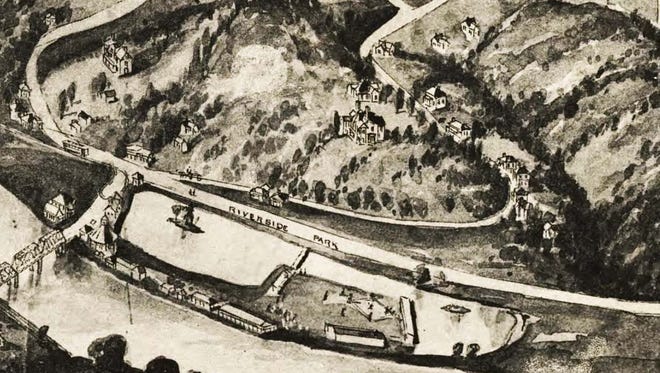 Riverside Park in Asheville, North Carolina, 1912. The baseball diamond is near the bottom of the drawing. Foul balls and home runs often ended up in the water. From the Asheville Citizen-Times.
Riverside Park in Asheville, North Carolina, 1912. The baseball diamond is near the bottom of the drawing. Foul balls and home runs often ended up in the water. From the Asheville Citizen-Times.
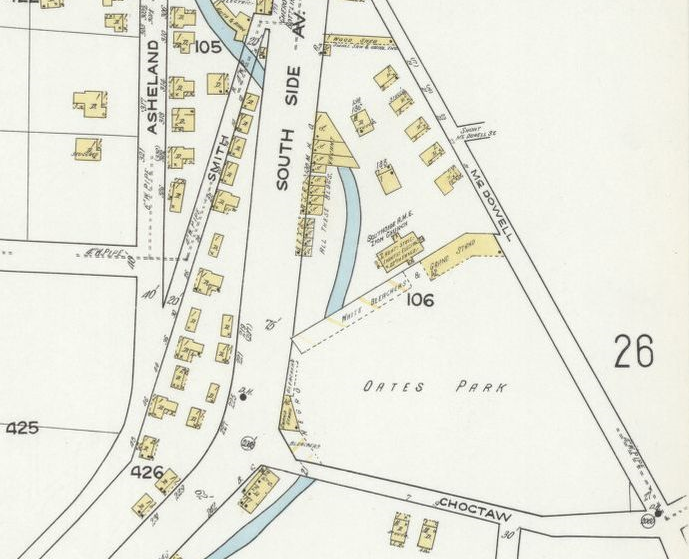 Oates Park was located between South Side, Choctaw, and McDowell streets. Home plate was to the north; the left field corner was at the intersection of Choctaw and McDowell. The bleachers and grandstand on the first base side were for whites; Black fans were seated in the bleachers and grandstands in the right field corner. Sanborn Fire Insurance Map for Asheville, Buncombe County, North Carolina, 1917, Sheet 25. From the Library of Congress.
Oates Park was located between South Side, Choctaw, and McDowell streets. Home plate was to the north; the left field corner was at the intersection of Choctaw and McDowell. The bleachers and grandstand on the first base side were for whites; Black fans were seated in the bleachers and grandstands in the right field corner. Sanborn Fire Insurance Map for Asheville, Buncombe County, North Carolina, 1917, Sheet 25. From the Library of Congress.
The Asheville Club — referred to in the sports pages as both the Mountaineers and the Tourists, and sometimes as the Paramounts — opened the 1913 season with the ancient, 43-year-old Tommy Stouch managing and playing second base, a job that he performed poorly. If the ball did not bounce directly at Stouch, he would let it roll through the infield for a hit. In late May, the club kicked Stouch upstairs to be Second Vice President; outfielder Lonnie Noojin replaced him as player-manager.
The team finished the year fourth in the six-team North Carolina League. Noojin departed to become the head football coach at Howard College (now Samford University), and Stouch resigned. It was a successful year for Corbett, though, as he finished the season with a .290 batting average and, playing primarily at shortstop, a .904 fielding average.
 Two articles from the Asheville Citizen-Times, 1913. The article on the left, published July 7, uses ‘Mountaineers’ in the main headline and ‘Tourists’ in the sub-headline. The article on the right, published July 10, uses ‘Tourists’ in the main headline and ‘Mountaineers’ in the sub-headline.
Two articles from the Asheville Citizen-Times, 1913. The article on the left, published July 7, uses ‘Mountaineers’ in the main headline and ‘Tourists’ in the sub-headline. The article on the right, published July 10, uses ‘Tourists’ in the main headline and ‘Mountaineers’ in the sub-headline.
The Asheville club went into the 1914 season with much optimism — as is the grand tradition among baseball’s fans and players. Louis Cook, a 32-year-old infielder who had never risen higher than Class B ball, was hired as player-manager. Cook did not take a great interest in the job. He remained at his home in Illinois until late February, and when he finally showed up in Asheville, Cook spent much of his time coaching the baseball team at nearby Mars Hill College.
In the days before the development of the modern farm system, in which a ‘parent’ major league club provides players to its minor league franchises, each minor league team was an independent operation responsible for scouting and signing its own talent. Cook did not participate in the recruitment process, relying instead on the club’s business secretary, Mr. Thomas M. Duckett, to find suitable players. Duckett cast a wide net, bringing twenty-nine recruits to Asheville. Cook then whittled the crowd down to the thirteen-player limit — including the player-manager — that Class D teams were allowed by the National Association of Professional Base Ball Leagues.
The Tourists performed miserably. In early June, with the club dead last in the North Carolina League standings and sporting an 11-27 record, Cook resigned. Jack Corbett became the new player-manager. The team performed better under Corbett’s direction but finished last in the league with a 46-74 record. Corbett’s final batting average was .272. His fielding averages were .975 at second base (40 games) and .916 at shortstop (69 games).
Corbett brought an energy to the job that his predecessors lacked. Immediately after the 1914 season ended, the 27-year-old manager went on a lengthy scouting trip to find ballplayers that met his standards, traveling through the North, Midwest, and West. In October, he tagged along with the Cincinnati Reds on a post-season barnstorming tour through small Ohio towns where, the Citizen-Times said, ‘It is expected that many embryo phenoms may be uncovered.’ In late November, Corbett was reported to be ‘in an argument’ with the manager of a Texas League club concerning the services of a prospective pitcher.
Corbett finally returned to Asheville in mid-December. After wrapping up some plans for the coming season, he left for his home in Richwood, Ohio. But he was back in Asheville on December 27, saying that Santa had left ‘a contract or two in his stocking.’
Besides being a player and the team’s manager, Corbett was the Asheville club’s secretary-treasurer and served on its board of directors. He negotiated with major league clubs for exhibition games and planned the Tourists’ spring training in Morganton.
Corbett is maintaining headquarters at the office of Secretary Thomas M. Duckett, in the Westall building, for the present, although he has not regular hours. Most of his business is being transacted over the counters of the cigar stores and around radiators of the drug stores. He admits that he isn’t a very good office man, being too much of a rambler to get his desk cluttered up with papers. His card index system is at the end of his tongue and he carries his plans for the future in his head. — Asheville Citizen-Times, December 30, 1914
The new manager’s efforts paid off. With Corbett playing shortstop, the 1915 Tourists finished at the top of the North Carolina League standings in both halves of a split season, then defeated the champions of the Virginia League in a best-of-seven series. Corbett became known around Asheville as ‘The Tourists’ Guide,’ and the fans presented him with a gold watch.
But a late-season incident demonstrated Corbett’s unwillingness to suffer the slings of those he considered his inferiors. During a September 1 game against Charlotte in Oates Park, the umpire, a former ballplayer who had toiled for sixteen years in the minors named Edward Pleiades Lauzon, handed out several calls that the locals perceived as unjust, raising the ire of the fans and, in particular, of Jack Corbett.
Asheville was trailing 1-3 in the ninth inning with a runner on first base and no outs. The Tourists’ batter smacked the ball down the right field line, moving the runner to third. But Lauzon ruled it a foul ball, sending the runner back to first. Corbett, coaching third base, protested vigorously and was ejected from the game. The batter returned to the plate and promptly struck out, and the next hitter flied to left. The following batter lined a double into the left field corner, scoring the runner from first. If the previous foul ball had been ruled fair, the double would have scored two runs to tie the game. With the tying run now at second, Asheville’s last batter struck out to end the ballgame.
‘After the game,’ according to the Asheville Gazette-News, ‘a mob of incensed fans rushed onto the field to attack the umpire, but Chief of Police L.E. Perry and some of his policemen were “Johnnies on the spot” and “The Honorable Mr.” Lauzon probably has to thank the Asheville constabulary that he escaped personal injury.’
Corbett confronted Mr. Lauzon and, in the sanitized words of the Citizen-Times, made ‘statements to him’ that ‘were most uncomplimentary and exceedingly insulting.’
The umpire fined Corbett $35. North Carolina League president Arthur Lyon upheld the fine and ordered Corbett to apologize to Lauzon. Corbett refused to remit either the fine or the apology, and Lyon suspended him for the remainder of the season. Although unable to take the field, Corbett continued to direct the club as its ‘Business Manager.’
Kicking — showing displeasure at the umpire’s calls — was a habit with Corbett, one that he elevated to performance art involving the entire team. A 1916 item in the Charlotte News offers an insight into the Tourists’ antics: ‘On every pitch that comes within reaching distance of the catcher that is called a ball by the umps, Corbett takes off his glove and looks to Hickman. Hickman yells. Bradshaw takes off his glove and stares. Bitting takes off his glove, walks around a bit and throws an imaginary pebble over toward the bleachers. Mack can’t figure out why so he does an Indian war dance. If Asheville would cut out a bit of their kicking — if Asheville would only cut out their unnecessary kicking, the towns around the circuit would take much more delight in seeing them come for a three-day engagement.’
Jack Corbett’s love of theatrics and his intolerance of perceived inferiors would claim another victim in the form of Walter Ancker.
—-
It is unclear how the Asheville Tourists acquired Walter Ancker’s contract from the Philadelphia Athletics or whether Corbett personally met and worked out Ancker before purchasing his contract from Connie Mack.
After the 1915 season ended, Corbett journeyed to the Northeast, where he watched the World Series games between the Philadelphia Phillies and the Boston Braves and met with the managers of multiple major league clubs. He returned to Asheville on October 19 and announced that he had acquired the contracts of ‘a number of new men,’ but that he was not at liberty to reveal their names. Corbett likely visited Connie Mack on this trip; he was a good friend of Earle Mack and had served as the best man at Earle’s wedding on September 28, 1915. At Connie Mack’s suggestion, Corbett may have taken the train to Hackensack to see Ancker in action.
While Corbett was on his northeastern tour, Ancker pitched for the Tenafly Baseball Club in a Columbus Day exhibition game against the Oritani Field Club. Ancker struck out sixteen or seventeen batters (depending on which newspaper one subscribed to) and gave up three hits and no runs. Oritani’s pitcher, major leaguer Harry Harper, pitched a no-hitter. The game ended in a 0-0 tie as darkness loomed. Four days later, Ancker pitched for a team of local all-stars against a barnstorming squad led by future Hall of Famer Rube Marquard. Ancker allowed one run, two hits, and struck out nine as the All Stars downed the ‘cracks’ 2-1. If Corbett witnessed either of these games, he might have been impressed enough to purchase Ancker’s contract from the Athletics.
In late 1915 Corbett confided to a reporter with the Citizen-Times that a major league team had promised to supply two pitchers to the Asheville club. The plan was for Corbett to ‘visit the spring training camp of the big league team in question, and when the manager of that team decides what pitchers he wants to retain, Manager Corbett will be given first pick of those to be “farmed” for the next season.’
A subsequent story in the Citizen-Times, published March 31, 1916, mentioned that Ancker ‘is in good playing condition, having been with Connie Mack’s Athletics on their training trip.’ And an April 5 article in the same paper claimed that Ancker ‘has been training with Connie’s bunch down among the sweltering pines.’ Based on this information, one might surmise that Corbett observed Ancker at the Athletics’ spring training camp in Jacksonville, Florida, purchased his contract there, and brought him to Asheville.
But the Ancker-was-in-Florida theory doesn’t hold up. Connie Mack announced Ancker’s sale to the Tourists on February 28. The Athletics’ pitchers and catchers departed for Florida, by steamship, on March 8 (pitchers and catchers, by longstanding tradition, opened spring training a week before the arrival of infielders and outfielders). Ancker was not among the departees listed in a Philadelphia Inquirer article about the trip.
When Corbett wrote to Ancker on March 7, he addressed the letter to Ancker’s home in Closter, New Jersey. And Ancker and Earle Mack left Philadelphia for Asheville on March 28. The Citizen-Times sportswriter was probably mistaken or misinformed about Ancker being in Florida. Hearing that Ancker ‘had been with the Athletics,’ and being aware of Corbett’s plan to capture pitchers in Florida, he may have stumbled to the incorrect conclusion that Ancker had been at Connie Mack’s spring training camp.
—-
The Tourists were struggling financially, as were most minor league teams of the era. To hold down expenses, Corbett brought a minimal number of players to spring training. He announced that the preseason squad would comprise ‘not over fifteen men.’ But even with a slimmed-down training camp, the cost of transporting the men to Asheville, and paying their room and board, represented a significant expense for the cash-strapped club.
The Tourists offset their spring training costs by selling books of regular-season tickets. A book of twenty-five children’s tickets cost $1.00, and a book of twenty-five ladies’ tickets cost $2.50. For men, a book of four tickets cost $1.00, which was not a bargain since the regular price of admission to Oates Park was 25 cents. The plan demonstrated Corbett’s canny marketing genius: lure the wife and kids to the park with discounted tickets and make the husband — who was obligated to escort his family — pay full price.
The Asheville fans got their first formal views of Corbett’s new 1916 Tourists in a pair of exhibition games, played in Oates Park on April 5 and 6, against the Philadelphia Athletics. Connie Mack was not with his barnstorming squad — dubbed the Yannigans, a now-obsolete term for scrubs or rookies — having entrusted its care to coach Ira Thomas.
Connie Mack was still stirring his pot, attempting to create a winning combination using raw rookies and cast-offs. The only face on the Yannigans that was familiar to Ancker was forty-one-year-old Napoleon ‘Larry’ Lajoie, commencing his twenty-first and final major league season. Ancker may have been glad to see the infielder who had played behind him when he pitched for the Athletics. But he ruefully remembered the grounder Lajoie booted in Ancker’s start last fall against the Senators. A putout would have ended the inning. Instead, the error unnerved Ancker and opened the door for a single, two walks, a wild pitch, two unearned runs, and Ancker’s banishment to the bench.
Corbett did not use his regular pitchers against the Athletics. He recruited local talents, a stunt guaranteed to attract spectators to Oates Park. In the April 5 game, the Athletics faced Harry Allison, a high school hurler; Cecil Bryson, a semi-pro southpaw from the nearby town of Sylva; and a cadet from Bingham Military School named Bland. The David vs. Goliath match-up drew 1000 fans on a chilly Wednesday afternoon, including, the Citizen-Times’ reporter observed, ‘a large number of the fair sex.’ The assembled masses watched the Tourists lose to the big leaguers 2-3 in a game called after eight innings due to encroaching darkness.
Between the third and fourth innings, Mr. L.L. Jenkins, president of the Asheville club, appeared on the field wearing a Tourists uniform and invited everyone in attendance to a ‘monster banquet’ to be held that night at the Langren Hotel.
Jenkins expected a crowd of 300, but only 100 turned up. Those who attended enjoyed a fine meal in the hotel’s main dining room, serenaded by the Langren orchestra. A parade of twenty-seven speakers passed the podium, including President Jenkins — who urged the attendees to buy the bonds he had issued to finance the team — along with several local businessmen, Jack Corbett, and players from both the Athletics and the Tourists. Walter Ancker was listed last in the Citizen-Times’ review of the event, probably indicating his order in the program. There is no record of Ancker’s remarks or the number of attendees still present and awake to hear them.
Attendance was down for the Thursday game, with only 600 souls in the grandstand. Corbett again sent Allison and Bryson to the mound. Harry Watson, a former Asheville pitcher, also made an appearance. The faithful witnessed another defeat, with the Tourists losing 2-6. Ancker made it into the game, pinch hitting for Earle Mack — and recording an out — in the ninth inning.
An incident in the top of the seventh inning added some amusement. After the Athletics made their third out, a new Philadelphia batter stepped up to the plate. Allison prepared to pitch to him, both batter and pitcher unaware that the side had been retired. The umpires for the game, Asheville pitchers Ernie ‘Doc’ Ferris and George ‘Doc’ Lowe, were equally oblivious. The scorers in the press box tried to get their attention, but it required the shouts of the spectators to bring the inning to its proper close.
George Lowe was probably known to Ancker prior to his arrival in Asheville. He was a Bergen County boy from Ridgefield Park. Though two years older than Ancker, he and Ancker had surely crossed basepaths around Hackensack before both arrived in Asheville; they would meet again in Hackensack later in 1916.
On the Monday following the exhibition games, sportswriters — and other loafers who had nothing better to do on a weekday morning but hang around Oates Park — witnessed a mound session by Ancker and Jack Harper, a pitcher whose fate intertwined with Ancker’s.
Harper had been, like Ancker, one of Connie Mack’s 1915 kid flingers. His cup of coffee with the Athletics was even briefer than Ancker’s. Harper appeared in three early-season games, pitching a total of eight-and-two-thirds innings. Harper was already well-known in Asheville, having previously pitched in the North Carolina League for Greensboro and Raleigh.
After witnessing the workout, an anonymous reporter for the Citizen-Times declared that the two pitchers had ‘everything in the world.’ He judged that Harper was ‘better this year than last.’
The writer was impressed with Ancker’s size: ‘Ancker is an ideal pitcher. He is big and husky, built for plenty of work, has a wealth of smoke and an assortment of curves that promises to keep the Carolina batters reaching in vain throughout the season.’
Oates Park needed repairs before the season opened, so Corbett’s club decamped for Gastonia on Wednesday morning, April 12. President L.L. Jenkins was a native of the town, with interests there in textile mills, banking, and politics. Jenkins arranged for the Tourists to train at Gastonia’s Loray Park.
Loray Park was more run-down than Oates Park, featuring a large gap in the center field fence. During a game the previous year, the grandstand had been rumored to be on the verge of collapse. ‘The infield here is not the best that there is,’ the Citizen-Times complained, ‘but this is being treated by several men each day and will soon be in good shape.’
The day after their move to Gastonia, the Tourists played an exhibition game against the Columbia Comers of the Class C South Atlantic League. Six hundred fans saw Asheville lose 6-8. Walter Ancker started the game for Asheville, earning the distinction of being the first regular Tourist pitcher to take the mound in 1916, and was relieved by Doc Ferris. The published box scores are incomplete, but Ancker probably pitched five innings, gave up two runs, struck out three, and walked one. The Citizen-Times reported that ‘Ancker went good.’
Columbia scored a two-run homer off Ancker in the second inning when, with a runner on second, a ball rolled through the hole in the center field fence. Today the hit would be a ground rule double. But in 1916, any ball that bounced over or rolled through the outfield fence was a home run. Ancker reclaimed a run for himself in the following inning when he poled a legitimate homer over the right field fence.
Corbett, as usual, took umbrage with the umpire, a local man named Miller, and argued a ninth-inning call at second base so strenuously that Mr. Miller fled the field in fear for his safety.
The Tourists played another exhibition game against the Comers the following day, with Jack Harper and George Lowe pitching for Asheville before an audience of 300. High winds created a minor dust storm in the grassless Loray Park. A similar gale had blown in a game the previous month, kicking up a cloud of sand so thick that the spectators in the grandstand could not see the infielders.
Another problem for Corbett was an injury to his second baseman, Dallas ‘Rabbit’ Bradshaw. For unknown reasons, Corbett borrowed an infielder from the Comers. The conscript made several ‘errors’ and, when he did field the ball, refused to throw it anywhere. The game ended after seven innings with the score tied 7-7.
Asheville’s final game in Gastonia took place on Saturday, April 15. The Tourists took on a patched-together squad comprising five Columbia players, two Asheville players, and various local talents. Details of the bout have not survived, but Asheville left the field with a 12-3 victory.
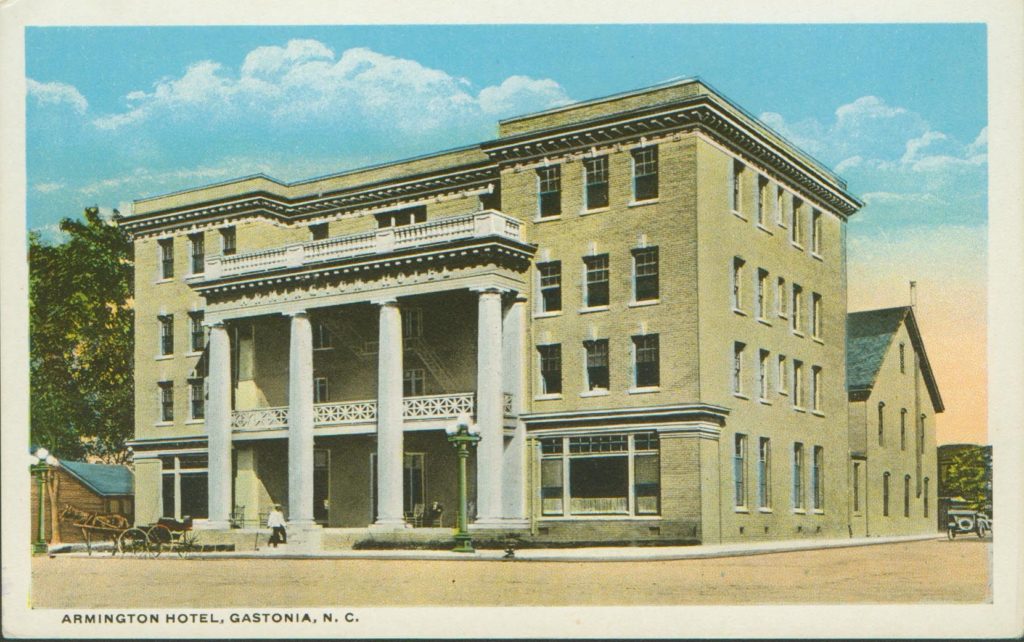 Armington Hotel, Gastonia, North Carolina, 1915.
Armington Hotel, Gastonia, North Carolina, 1915.
The Tourists stayed at the Armington Hotel during their sojourn in Gastonia. On the Sunday evening before their departure, the hotel manager treated the team to a complimentary dinner with menu items named for the players. The meal included Corbett Cocktail, Queen Lowe Olives, and Harper Brew (coffee). The entrée, Prime Cut of Roast Beef a la Bitting, honored Earl Bitting, the Tourists’ third baseman and cleanup hitter.
The chef was not a fine student of the game. He transformed Earle Mack into his three-year-old half-brother in the form of Connie Mack, Jr. Rolls. Regarding Walter Ancker’s role in the affair, the Citizen-Times wag who was following the team noted, ‘It is not believed that the promising new twirler is green, albeit his name was presented as “Ancker Salad.”‘ And perhaps proving that he had imbibed too many Corbett Cocktails, the writer included this cringeworthy tidbit about the team’s first baseman, rookie Ernie Burke: ‘The author of the menu, evidently was wised to the new Asheville first sacker’s fondness for members of the fair sex, for his name appeared as “Young Chicken Burke Dressing.”‘
The Tourists returned to Oates Park for two games against Tennessee’s Maryville College. The Maryville team was fast — meaning a very good baseball club. Some of its players were not, in the strictest sense of the word, amateurs. Their pitcher in the first game, an Alabama boy named J. Frank Whitney, had been signed by the Birmingham Barons of the Class A Southern League in 1913. The Barons sold his contract to the Newnan (Georgia) Cowetas of the Class D Georgia-Alabama League, where he pitched in 1914 and 1915, compiling an 8-7 record in the latter season.
In July 1915, a group of baseball fans in Gastonia, wishing to get in on the action of the three-team semi-pro Western North Carolina League (comprising Morganton, Statesville, and Lenoir), formed the Gastonia Athletic Association. They secured the services of the Newnan Cowetas — the struggling Georgia-Alabama League having completed a truncated season — and shipped the entire lot, including J. Frank Whitney, to Gastonia via the Southern Railway.
The ‘new’ team, christened the Gastonia Tigers, finished first in the Western North Carolina League in the second half of the split season. The Tigers then beat Morganton, the winner of the season’s first half, in a best-of-three series to take the pennant.
Chief Bender, who had already played twelve years with the Philadelphia Athletics and who had never appeared with the Tigers, pitched a complete-game victory in the series opener. The next day he came on in relief of Whitney, who left in the seventh inning with the Tigers leading, and finished the game without yielding an additional run. It was perfectly acceptable for a future Hall of Famer to show up and pitch in a semi-pro league’s championship series.
How Frank Whitney (or Bill Whitney, as the Gastonia and Tennessee newspapers called him) ended up pitching for Maryville College, and whether the school paid him for his efforts, is a mystery. At any rate, he pitched a 16-inning complete game against the Tourists but lost 5-6 as Corbett sent Ferris and Olin Perritt to the mound. The collegiates won the second game, 7-3, with Harper and Lowe pitching for Asheville.
Miss Helen Keller arrived in Asheville on Thursday, April 20, to deliver a lecture on Happiness. Billed as ‘The World’s Eighth Wonder,’ she was on a tour of North Carolina cities, accompanied by her teacher, Mrs. Anne Sullivan Macy. A witness to her lecture in Charlotte considered the evening to be a life-changing event, declaring ‘none who had that experience can ever be quite the same afterwards as before.’
Asheville’s final exhibition game took place April 22 on a pleasant Saturday afternoon with temperatures in the low 60’s. The Tourists plastered the cadets of Bingham Military School 15-4. Ferris started for the Tourists, with Ancker and Lowe following in relief. Ferris allowed two runs in the second inning, and the cadets tagged Ancker for two runs in the seventh. Bingham recorded a total of four hits, one being a triple.
Asheville went into the regular season with a pitching staff comprising Ferris, Harper, Perritt, Lowe, and Ancker. Perritt, who could catch and play the field, was also the team’s utility man. The Greensboro Daily News recognized that Ancker was at the bottom of the rotation: ‘The fifth member of the hurling corps, Ancker, was secured from Connie Mack. He has an excellent fast ball and his curve, or hook, is breaking nicely. Corbett is positive that Ancker will be a winner with the Paramounts, but for that matter he feels the same about the other four.’
—-
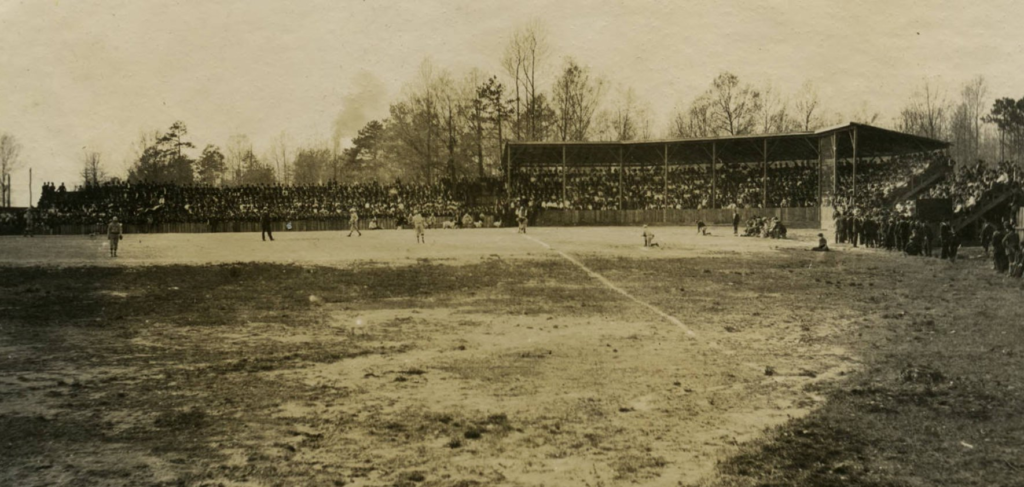 Cone Park in Greensboro. There appear to be animals — possibly goats — along the first base line. From Old Time Baseball Photos.
Cone Park in Greensboro. There appear to be animals — possibly goats — along the first base line. From Old Time Baseball Photos.
The North Carolina League commenced its 1916 regular season on Wednesday, April 26, with games in Durham, Charlotte, and Greensboro, where the Tourists took on the Patriots (usually called the Goats). Plans called for new Saxon automobiles provided by the Paige Sales Company to carry the players from the Clegg Hotel through the business district to Cone Park.
‘The game this afternoon will start at 4 o’clock,’ predicted a cynic at the Greensboro Daily News, ‘and some distinguished citizen will probably walk out into the middle of the diamond and throw the ball in the general direction of home plate.’ The previous year in Winston-Salem, the mayor, Mr. O.B. Eaton, had been the designated distinguished citizen. He proceeded to heave the ball over the grandstand.
A drizzling rain put a damper on the festivities. The parade was reduced to a quick ride from the hotel directly to the ballpark, where 700 fans saw the Tourists down the Goats 6-2 with Ferris pitching a complete game. The Tourists followed it up the next day with another win against the Goats, 9-6, as Harper also pitched a complete game.
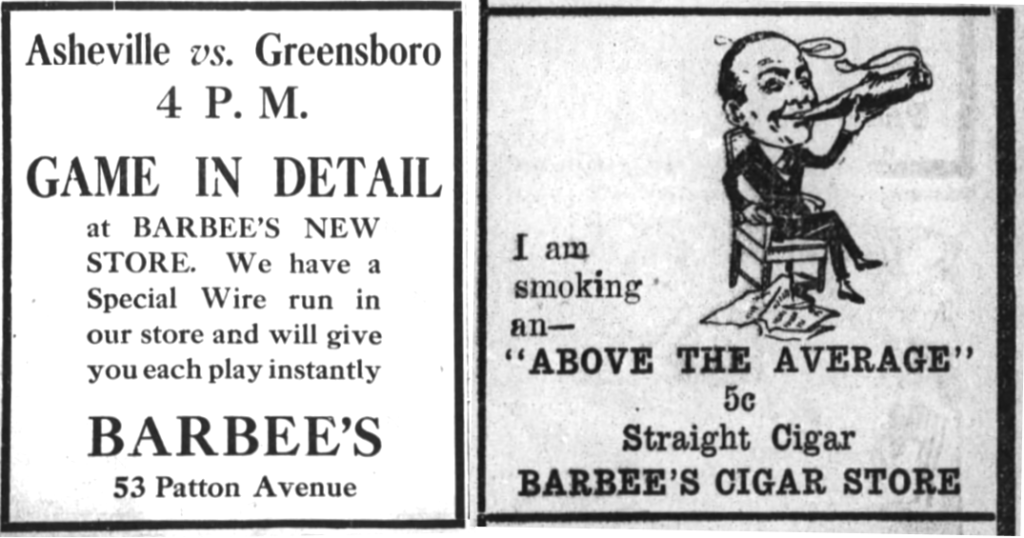 Advertisements for Barbee’s Cigar Store in the Asheville Citizen-Times, 1916. The store held its Grand Opening on April 13, offering a ‘REAL Cigar’ for each man who entered and a box of candy for each lady. An orchestra serenaded the visitors.
Advertisements for Barbee’s Cigar Store in the Asheville Citizen-Times, 1916. The store held its Grand Opening on April 13, offering a ‘REAL Cigar’ for each man who entered and a box of candy for each lady. An orchestra serenaded the visitors.
The club returned to Asheville for their first home game, and 1,967 fans packed into Oates Park on a Friday afternoon to see the Tourists take on the Charlotte Hornets. Those locals who were not inclined to attend in person followed the action in the brand-new Barbee’s Cigar Store, where a Special Wire brought the results of each at-bat. The faithful fans who filled the park got their money’s worth, witnessing a 15-inning, three-hour marathon that began at 4 PM and ended just fifteen minutes shy of sundown. The hometown boys lost 4-6 behind the pitching of Perritt and Lowe.
Walter Ancker finally saw regular-season action on Saturday, April 29, against Charlotte. If Corbett was using a five-man rotation (Ferris, Harper, Perritt, Lowe, Ancker), then Ancker should have started the game. Instead, Corbett skipped back to Doc Ferris, using Ancker as a reliever.
The game was covered for the Citizen-Times by Mr. L.M. Cadison, a former reporter, sportswriter, and business manager with the Pittsburgh Press who had relocated to Asheville. Describing the performance of starting pitcher Ferris, Cadison pulled out all the stops: ‘Commander Corbett selected Doc Ferris, who won the opener in Greensboro last Wednesday, to do the twirling honors here yesterday afternoon, but the terrible home-run inflicting bombardment sent the Doctor to the discard in the early part of the sixth chapter. It was not a day for Ferris — that is all there is to it. My what a terrific fusillade of hefty swats met the delivery of the physician. Right on the jump he got himself in hot water and remained submerged until Captain Corbett had compassion on the victim, and incidentally on the fans, and delegated him to the cool showers.’
With no outs and Asheville trailing 7-8 in the top of the sixth inning, Ferris having just given up a two-run homer, Ancker entered the game and struck out the side. Mr. Cadison felt that Ancker ‘made a very favorable impression.’
The eighth inning was a different story, one of those Walter Ancker Specials that had haunted him the previous year in Philadelphia. After striking out the leadoff batter, Ancker surrendered a walk, a double, an infield hit, and a wild pitch. After an error by Corbett, the carnage continued with a single, a flyout, and another single. The Good Mr. Cadison did not reveal how the inning ended, but Ancker gave up three runs before leaving the mound. Ancker was still in the habit of pitching well in one inning, then completely melting down in the next.
The game ended with Asheville winning 12-11. By today’s rules, Ancker would receive the win, having entered the game with the Tourists losing. Pitching the final four innings, Ancker gave up three runs and seven hits, struck out five, and walked four. The writer for the Greensboro Daily News was less than dazzled: ‘As a hit fest the game was a masterpiece; as a baseball game it was horrible exhibit No. 1… Not one of the four pitchers used was effective.’
With the initial games of the season behind them, the teams of the North Carolina League took up their usual routine: two three-game series each week, Monday through Wednesday, and Thursday through Saturday. There were no games on Sunday as the Blue Laws in most southern towns prohibited businesses from operating and because ballparks were generally acknowledged to be dens of iniquity.
The Tourists’ first three-game series was a road trip to Durham with complete games by Harper (lost 1-7), Lowe (won 4-2), and Ferris (lost 1-13). Moving to Winston-Salem, Perritt lost a complete game to the Twins, 7-8. Ancker made his first regular-season start the following day, Friday, May 5, in front of 900 fans in the Twins’ Prince Albert Park.
The first seven innings were Ancker’s typical blend of wildness and grit. He gave up seven hits, walked five, and a hit batter. The Twins had runners incessantly on base, but Ancker surrendered only a pair of runs, one in the fourth inning and another in the sixth.
Ancker walked to the mound in the bottom of the eighth inning with the score tied 2-2. He then handed the Twins the proverbial Big Inning, the inning that Walter Ancker experienced in almost every professional game. He plunked the first batter on the arm, got the next man on an outfield fly, then gave up a double and a home run for a three-run inning. Asheville plated a single run in the ninth, and the game ended in a 3-5 loss for the Tourists. The final line for Ancker: five runs, ten hits, three strikeouts, five walks, and two hit batters.
The Twins started Johnny Meador, who was replaced in the second inning by Whitey Glazner. The Citizen-Times reporter panned Ancker and Glazner equally: ‘Both Ancker and Glazner were rather free with the passes, the Twin pitcher walking five men [the box score indicates four walks by Glazner and one by Meador] and the Asheville slab performer granting five free tickets to first, besides hitting two Twin players by way of diversion.’
The loss could not have made Jack Corbett happy. Corbett valued pitchers who could ply their trade consistently, walking few and piling up the innings. He wasn’t looking for Walter Johnson. He just needed pitchers who could hold the lid down long enough for the Tourists to string together a few runs. Walks, hit batters, and wild pitches were signs of imperfection, even weakness.
There was something uncanny about the predictability of the Walter Ancker Special, the Big Inning in which Ancker would suddenly forget how to pitch. A great pitch and a terrible pitch are differentiated by tiny tolerances in the combinations of force, finger position, and release point. Ancker could, usually, produce combinations that created good-if-not-great pitches. But, given enough time, Ancker could be counted on to lapse into combinations that caused the ball to avoid the strike zone as if that rectangular cuboid was repellant to horsehide. The only solution in such extremities was to groove the ball down the middle and hope for the best.
Ancker was a strikeout artist on the dusty diamonds of northeast New Jersey, where the Bergen County boys would hack away at anything that approached the plate. There, Ancker’s wildness was practically an asset. If they’re going to be swinging, why not let them swing at a ball in the dirt? But the pros were a cannier bunch, choosing to wait until a pitch came right down the pipe.
The height of the pitcher’s mound probably played a part in Ancker’s wildness. Before 1950, a major league mound could be any height between a flat surface and a 15-inch mountain. Many non-professional ballparks in Ancker’s era had no pitcher’s mound at all. A pitcher accustomed to throwing from one elevation would have difficulty adjusting to a different crest.
Bruno Haas, yet another of Connie Mack’s 1915 kid flingers, had great control when pitching from the unelevated plane at Massachusetts’ Worchester Academy. But when placed on the hill in Shibe Park, which was at least 12 inches high (it measured slightly over 13 inches in 1941), his control vanished. Connie Mack explained the conundrum: ‘The pitching mound fooled him. Twirling on scholastic diamonds, where he stood on a level with the plate, was what he had been accustomed to. When he was lifted into the air a foot or more by the big league mound, it threw off his delivery. We are coaching him out of his trouble rapidly and I believe he will make a valuable player.’
Haas must have learned something. Though he lasted only twelve games with the Athletics, he went on to play parts of twenty-one seasons in the minors. He pitched his last professional game for Class C Fargo-Morehead when he was 55 years old.
The mounds on the semi-pro fields of New Jersey were probably flat, or nearly so, while the North Carolina League mounds had some significant topography. An April 1915 item in the Winston-Salem Twin-City Daily Sentinel, regarding a Twins recruit named Roy Foley, offers this tidbit of insight: ‘Foley says that up in New York, where he hails from, they do not use a pitchers’ mound and for this reason, he has been experiencing trouble in getting the ball down. He expects to master the stunt after a few more trials in the box.’
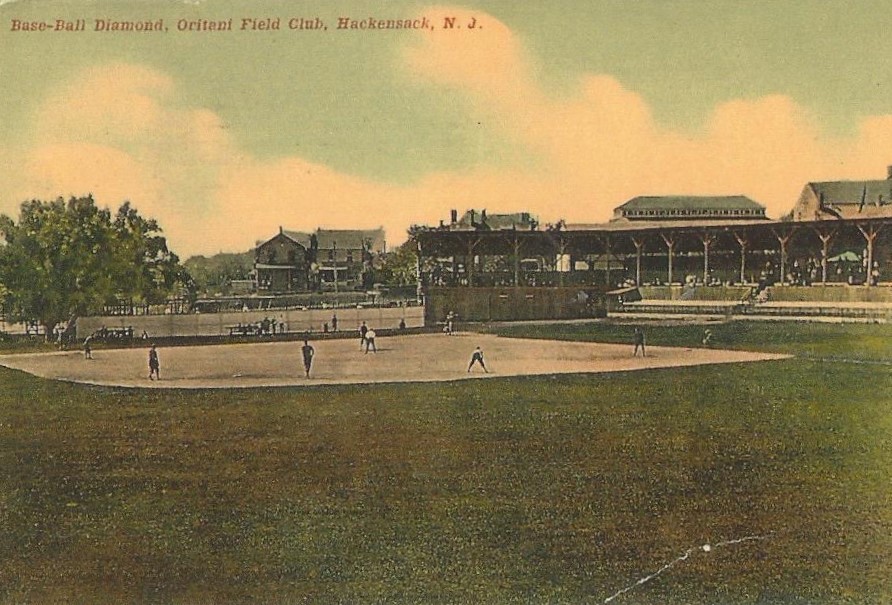 Postcard showing the Oritani Field Club in Hackensack, New Jersey, circa 1911. It is difficult to glean any definite conclusions, but the pitcher’s mound does not seem to have a significant elevation. The umpire is standing behind the pitcher; they are on a similar plane. The third base side features an enormous swath of foul territory. On the first base side, players lounge beneath a shade tree.
Postcard showing the Oritani Field Club in Hackensack, New Jersey, circa 1911. It is difficult to glean any definite conclusions, but the pitcher’s mound does not seem to have a significant elevation. The umpire is standing behind the pitcher; they are on a similar plane. The third base side features an enormous swath of foul territory. On the first base side, players lounge beneath a shade tree.
Foley’s home base was Fort Slocum, New York, an army post near New Rochelle, just eleven miles as the crow flies from Walter Ancker’s home in Closter. Around Fort Slocum, he was known as Cannonball Foley and averaged sixteen strikeouts per game. In Winston-Salem, he never mastered the ‘stunt’ of pitching from a mound and was released early in the season.
Following Ancker’s disappointing loss to the Twins, the Tourists ended their stay in Winston-Salem with a Saturday afternoon blowout. Harper pitched a complete game, and the Tourists won 13-5.
Corbett made some changes over the weekend. Doc Ferris was sold upstairs to the Columbia Comers of the Class C South Atlantic League. Ferris was a veteran who had won 27 games in 1915. He had so far made three appearances, pitched twenty-two innings, and recorded — by the modern method of reckoning — one win, one loss, and one no-decision. His strength was his control. He had walked only two batters, had not hit any, and had made no wild pitches. The trade-off was that he gave up a lot of hits and runs. Ferris was replaced on the roster by Frank Whitney, the Maryville College boy who had spun a 16-inning loss against the Tourists during the exhibition season.
Corbett played what would later be called Moneyball. With his club chronically short of cash, his most valuable assets were the contracts of his best players. He sold his stars to higher leagues and scavenged their replacements from whatever was below Class D. In this case, Corbett replaced a solid pitcher with one who had won eight games for Class D Newnan in 1915, had pitched well for semi-pro Gastonia, and had looked good in the April exhibition game against the Tourists. Whitney was not a proven commodity like Ferris, but Corbett felt he could hold his own against Class D batters. Corbett was an astute judge of ballplayers. He could use that ability to patch together a quality team with a low payroll.
The Tourists opened a three-game series against the Raleigh Capitals in Oates Park on Monday, May 8. The first encounters were complete-game wins by Lowe (8-1) and Perritt (9-7).
Wednesday was Confederate Memorial Day. May 10 marked the death of Stonewall Jackson in 1863 and the capture of Jefferson Davis in 1865. The former was the harbinger of the Confederacy’s demise; the latter was the final nail in the coffin. All banks in Asheville were closed, and veterans of the Confederate Army enjoyed refreshments in the rooms of the retail merchants association. The United Daughters of the Confederacy presented a program at the Majestic Theatre and decorated soldiers’ graves with flowers and Confederate flags.
That afternoon the newcomer, Whitney, drew the third start of the series. He was hammered, surrendering eight hits, including two doubles and two home runs. Ancker came on in relief in the top of the seventh inning with the Tourists trailing by two runs. He pitched two innings, allowed no hits or runs, struck out four, and walked three. The game was called after eight innings because the Capitals had to catch a train for Charlotte. Final score: 6-8 in favor of the visitors.
The Capitals were replaced in Oates Park by the cellar-dwelling Greensboro Goats. The Tourists led the rumens to the slaughterhouse with shutouts by Harper (13-0) and Perritt (2-0). The Goats regained some dignity in the final game as Lowe lost a close one, 1-2. After completing the series, Asheville stood in third place in the North Carolina League, only two games behind the first-place Charlotte Hornets. The Tourists would have a chance to catch and pass the Hornets the following week. The two teams would meet in Charlotte for a three-game series beginning on Monday.
—-
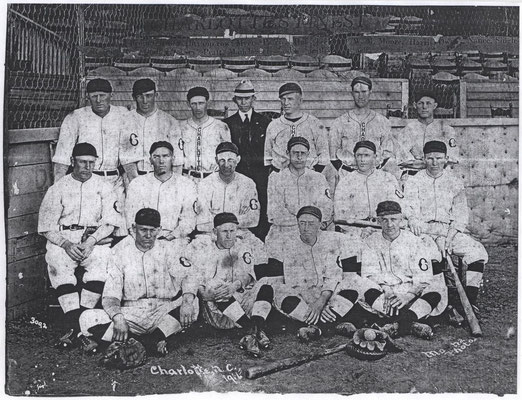 The Charlotte Hornets, 1916. From Queen City Baseball History.
The Charlotte Hornets, 1916. From Queen City Baseball History.
Asheville’s ballplayers filtered into the Southern Railway depot on Sunday morning, May 14, and gathered in the concourse. They wore their best clothes, but the coats and hats could not conceal the underlying coarseness. These were tough men, drifters who made their living playing baseball for small money, on scruffy fields fronted by wooden grandstands, for teams that were perpetually on the verge of bankruptcy.
There were twelve men in the group: Walter Ancker (pitcher), Dallas ‘Rabbit’ Bradshaw (second base), Earl Bitting (third base), Jack Corbett (shortstop), Guy ‘Rebel’ Dunning (right field, left field), Brooks Ellison (catcher), George ‘Doc’ Fenton (center field), Jack Harper (pitcher), Jimmy Hickman (center field, left field), Earle Mack (right field, first base), Olin Perritt (pitcher), and Frank ‘Lefty’ Whitney (pitcher). Two players would remain in Asheville. Ernie Burke (first base) was nursing a sore ankle, and George ‘Doc’ Lowe (pitcher) was resting up from yesterday’s complete-game shutout against the Goats.
Ancker, an electrician, was the only tradesman on the team. The others worked in the off-season as farmers or laborers, or in their family’s business. Only Earle Mack came from a prosperous family. Dunning’s father ran a store in Alabama. Bradshaw’s father sold insurance in Illinois. Hickman’s father was a traveling salesman in Tennessee. Ellison’s father traded cattle in Georgia. Harper’s father worked as a locomotive engineer in West Virginia.
A clot of white-whiskered men had gathered in another corner of the concourse. They were Confederate veterans waiting for the west-bound train that would carry them to Birmingham for the annual gathering of their former army. Each year, death and senility thinned the ranks.
Southern Railway No. 42 pulled into the station just before 7 AM and began to disgorge a very grumpy group of travelers. These were Southern Baptists arriving for their annual convention that would swell the population of Asheville by more than ten percent. When the last adherent had cleared the platform, the Tourists began to board the train bound for Spartanburg, Columbia, and Charleston. The team had an entourage. President Jenkins, some team directors, and assorted family members were tagging along. The morning air was in the low 60’s, but many of the ladies were ‘rushing the season’ by wearing their flouncy summer dresses.
Ostensibly present to support the team, Jenkins’ party was traveling to Charlotte to join in the May 20 Gala that was already taking the city in its grasp. The festival celebrated the signing of the Mecklenburg Declaration of Independence, a document dated May 20, 1775, in which Mecklenburg County declared itself independent of Great Britain. Since it pre-dated the Continental Congress’s Declaration of Independence by over a year, the Mecklenburg Declaration was said to be the Original Declaration, with Thomas Jefferson and his lot being mere copycats.
The signers of the Mecklenburg Declaration failed to tell anyone, including King George III, about their newfound freedom; the document’s existence did not come to light until forty-five years later. Today most scholars doubt the Declaration’s authenticity. But Mecklenburg Declaration Day was a significant event in 1916. President and Mrs. Woodrow Wilson, accompanied by the Marine Band, were the featured guests.
The conductor signaled the engineer that all were aboard, and the cars lurched forward. The train turned onto the tracks that led southeast through the fertile French Broad Basin, and Ancker watched the farms passing on both sides of the train. He recognized corn and potatoes, the grains he could never tell apart. Ancker wasn’t a farmer like Frank Whitney, but he knew that the crops were struggling. A serious drought was smothering Buncombe County. There was talk around Asheville of plowing under the oats and planting soybeans. The drought meant less grass in the parks and more dust in the ballplayers’ eyes. When a runner slid into a base — or slud as the southern boys said – he kicked up a blizzard of sand.
The train entered the mountains beyond Henderson, snaking through the gorges between the blue-hazed peaks and ridges, then descended into the flatlands of South Carolina.
The cars eased into Spartanburg at 10:30 AM, where the travelers disembarked to await the No. 12 train from Atlanta that would carry them to Gastonia. There were easier, faster ways to get from Asheville to Charlotte. But President Jenkins wanted to show his largesse by putting the team up for the night in the Armington Hotel and treating them to a fine dinner. The money might be better spent in shoring up the leaning fences of Oates Park, but no ballplayer would kick at the chance for a good meal and a clean bed.
They had a few hours to kill, so the Tourists split up to pursue their fancies. A few headed off in search of a church service. A couple produced their gloves and started tossing a ball around. Corbett hot-footed it to the Western Union office. There was always a clump of loafers hanging around the telegraph terminus in every small southern town. They might have a line on a local semi-pro star, or maybe a high school player who knew which end of the bat to hold. President Jenkins and his followers, seeking Sunday dinner, boarded a streetcar bound for the brand-new Hotel Cleveland. Ancker piled into the car with the players whose priority was determined by hunger.
In the hotel restaurant, the directors and the players sat at tables separated by a wide expanse of carpeted socio-economic real estate. A player slipped a flask from inside his coat and stealthily passed it around.
Ancker perused a newspaper. The cavalry was still chasing Pancho Villa. Each day, the papers reported that the bandit had been cornered. But in the next edition, Villa would turn up somewhere else. The big news was the Army Bill. The House and Senate had agreed to fund a standing army of 206,000 regulars that could be expanded to 254,000 in an emergency, backed by a national guard of 425,000 men. The players joked about who would be left to play baseball if they all ended up in the army.
In Europe, the Germans were attacking both the French at Verdun and the British along the Somme, while the Russians and the Turks were going at it in Armenia. Ancker had occasionally overheard a teammate mention ‘The Hun.’ It made him uneasy. He didn’t share that his father, and his mother’s parents, had been born in Germany.
Everyone trooped back to the depot around 3 PM, and boarded No. 12. Two hours later, they disgorged into the familiar environ of Gastonia, where the ball field featured dunes of dust and an inviting gap in the center field fence. It had been a long trip, and the travelers were glad that the Armington Hotel was just across West Airline Street from the Southern Railway passenger depot.
Over dinner that night, with President Jenkins playing the generous host, the players recalled the banquet that had been thrown in their honor the previous month and ticked off the menu items that had borrowed their names. The pitchers had been represented by Ancker Salad, Queen Lowe Olives, Perritt Cherry Pie, Harper Brew, and Ferris Cocoa. Someone suggested retroactively adding Whitney to the menu and, after considerable discussion, the players decided that the Alabama farm boy should be honored with Whitney Cornpone.
A topic of debate that was unvoiced, at least within earshot of Ancker, was Who’s gonna get cut? The rules of the North Carolina League and the National Association of Professional Base Ball Leagues allowed clubs to carry 22 players for the first 20 days of the season. But on the twentieth day, the roster had to be axed to 13 men. Corbett was carrying 14; someone had to go, and they had to go before Tuesday.
Some players were untouchable: Corbett, of course, and Mack, Hickman, Dunning, Bitting, Bradshaw, and Perritt. Ellison was the only true catcher, but Perritt and Mack had some experience behind the bat. Burke was injured, but he was a good hitter when healthy. A rumor was going around that Fenton’s contract had been sold, but Corbett denied its veracity.
The cut would probably be one of the pitchers, which meant either Whitney or Ancker. The surreptitiously-bet money was on Ancker. He was bringing up the cow’s tail of the rotation, having made only one start, the complete game against Winston-Salem that he blew in the eighth inning. Even counting his two relief appearances, Ancker had pitched just 15 innings. Perritt had 32, Harper had 35, and Lowe had pitched 37.
Whitney looked bad in his one start. But Whitney had been handpicked by Corbett just a week earlier, plucked from the depths of alleged academia. Everyone knew Corbett would give him at least one more start to prove himself. Ancker, on the other hand… Well, Corbett didn’t seem to like Ancker. There was a lack of respect, an impatience that bled into intolerance. Maybe the black-haired Corbett didn’t like Ancker’s head of reddish-brown hair. Or maybe he thought Ancker was just the big dumb guy.
In his 15 innings, Ancker had walked 12 batters and hit two, a total of 14 free passes or 0.93 free passes per inning. His nearest competitor was Jack Harper, whose 0.46 free passes per inning was less than half of Ancker’s. Lowe had the best ratio with 0.21, and Perritt was not far behind with 0.28.
The statistics available in the box scores fail to reveal other indicators of control: the pitch count and the number of balls vs. strikes. Ancker was probably throwing a large number of pitches, probably facing a lot of full counts. Nor do the numbers show the degree to which Ancker was missing the strike zone. In a box score, four pitches just off the outside corner are identical to four balls smothered in the dirt by the catcher. When a pitcher is continually described as wild, he’s likely missing the mark by a wide margin.
—-
The players enjoyed a late breakfast Monday morning, then made the obligatory visit to the Armington’s veranda where, on a clear day, Kings Mountain was visible to the south. Today, though, the view was obscured by clouds drifting in from the Gulf Coast that offered the opportunity for a dust-dampening evening shower. After recovering their bags from the lobby, they walked three blocks east down Airline to the Piedmont and Northern railway station.
The P&N ran an all-electric service with an ‘inter-urban’ passenger train departing for Charlotte every other hour. The players hauled their gear into a car at 11 AM. Sixty minutes later, they arrived at the P&N passenger depot at the corner of Mint and West Fourth. A half-mile streetcar ride southwest down Mint brought them to within a block of Wearn Field where the Tourists would meet the Hornets at 4 PM.
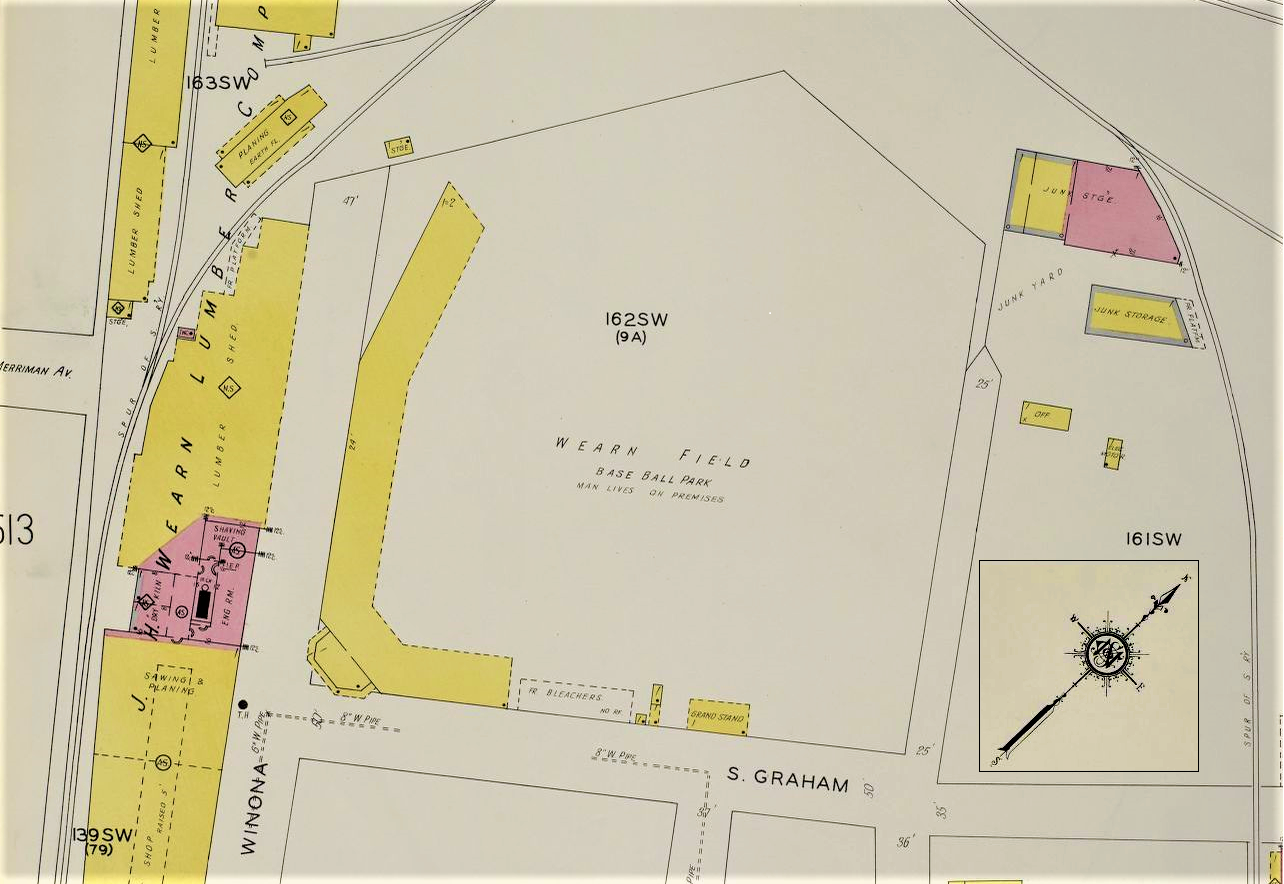 Wearn Field in Charlotte, North Carolina. Home plate was at the corner of South Graham and Winona. The right field corner was at South Graham and Commerce. The small print below ‘Wearn Field Base Ball Park’ reads ‘Man lives on premises.’ Note that the top of the map is northwest; the bottom of the map is southeast. Sanborn Fire Insurance Map of Charlotte, Mecklenburg County, North Carolina, 1929, Volume 2, Sheet 512. From the Library of Congress.
Wearn Field in Charlotte, North Carolina. Home plate was at the corner of South Graham and Winona. The right field corner was at South Graham and Commerce. The small print below ‘Wearn Field Base Ball Park’ reads ‘Man lives on premises.’ Note that the top of the map is northwest; the bottom of the map is southeast. Sanborn Fire Insurance Map of Charlotte, Mecklenburg County, North Carolina, 1929, Volume 2, Sheet 512. From the Library of Congress.
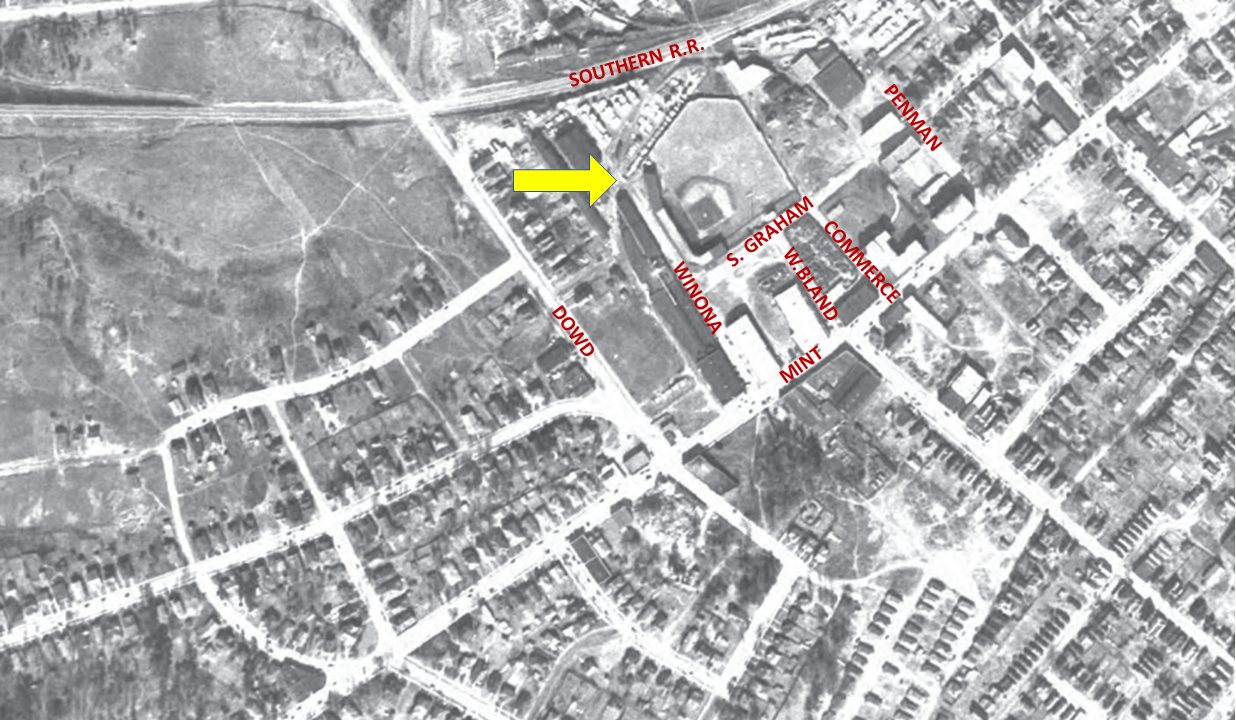 Aerial photo showing Wearn Field (yellow arrow), 1938. The site is now used to store construction equipment. From Urban Planet.
Aerial photo showing Wearn Field (yellow arrow), 1938. The site is now used to store construction equipment. From Urban Planet.
The players had predicted that Corbett would give Whitney at least one more start to prove his worth, and that start came Monday afternoon before a crowd of 900 fans. The game was umpired by Ed Lauzon, who had incurred Corbett’s wrath the previous September, earning the manager a fine and suspension.
The game began well for Asheville. Leadoff hitter Dallas Bradshaw hit one into the dirt in front of home plate but reached first on a throwing error by Charlotte’s catcher. Corbett singled, and both runners advanced on a sacrifice fly by left fielder Jimmy Hickman. Then third baseman and cleanup hitter Earl Bitting sent the ball over the left-center fence for a three-run homer.
Bitting began the 1915 season playing for the Charleston Sea Gulls of the Class C South Atlantic League. After the league completed its short season at the end of July, he moved to Lenoir of the semi-pro Western North Carolina League. As it happened, Bitting had also made commitments to play for two other WNCL teams, Statesville and Gastonia.
When Statesville threatened to pull out of the league if Bitting was allowed to play, the league president ruled that he could remain on Lenoir’s roster, but he would have to ride the bench whenever Lenoir met Statesville. After the regular season ended, Bitting joined the Gastonia squad, where Frank Whitney was a teammate, for the league championship series. Corbett acquired Bitting’s contract in late 1915.
Bitting’s blast would be all for the Tourists’ offense, but it was all Whitney needed. The lefthander was, in the words of the Citizen-Times, ‘wild as a hare.’ But he pitched well when it counted and benefitted from excellent play behind him.
The clouds were spitting rain throughout the game. The drizzle turned into a full-on downpour in the fourth inning, and umpire Lauzon called a 30-minute halt. The rain ceased, and the drought-starved sand dried out quickly.
The Hornets loaded the bases in the fifth inning, with one out and cleanup hitter Andy Anderson at the plate. Anderson ripped a liner down the third base line for what looked like a certain triple. But Bitting instinctively grabbed the ball with his bare hand and stepped on the base to double the runner.
Bitting’s double play seemingly occurred outside the normal time-space continuum. The Charlotte News reported that the play took place in the fifth inning with one out. The Charlotte Observer agreed that it happened in the fifth but was silent on the number of outs. The Asheville Citizen-Times claimed it was in the second inning with no outs, and the Durham Morning Herald placed it in the fourth inning with no outs. The Raleigh paper acknowledged the play but offered no details, and the Winston-Salem paper avoided the issue entirely. The out-of-town reporters probably received their information second-hand via telegraph, or by telephone from a stringer. It is also likely that any reporters on the scene were nipping from a flask.
Whitney was clinging to a 3-0 lead in the bottom of the ninth when the Hornets loaded the bases with one out, but a fly and a grounder ended the game. Whitney gave up seven hits and walked seven; the Hornets left 14 men on base. Corbett was willing to let Whitney work out of trouble, and he earned his manager’s trust by pitching a complete-game shutout.
After the game, the Shriners’ Arab Patrol drill team took over Wearn Field to practice. As the colorfully-clothed gentlemen marched across the outfield in close order, Corbett announced that he had released Jack Harper to make the 13-player roster limit. It was an odd choice. Harper had a 3-1 record, the best on the staff, and led the team in strikeouts with 18. There was speculation that Corbett was up to something.
—-
Lord, let me live like a Regular Man,
With Regular friends and true.
Let me play the game on a regular plan,
And play it all the way through.
Let me win or lose with a regular smile
And never be known to whine,
For that is a Regular Fellow’s style
And I want to make it mine!
— From ‘The Regular Man’ by Benton Braley, printed in the Gastonia Gazette, May 16, 1916
Tuesday, May 16, opened with the Tourists just a single game behind the Hornets. A win today and the pennant race would be knotted, with Wednesday’s game presenting a chance for Asheville to take the lead.
Before wandering to Wearn Field, the players enjoyed a bit of the holiday atmosphere that pervaded Charlotte. The Metropolitan Carnival had opened on Monday night; First Street between South Tryon and Church became a village of tents. The streets were alive with peddlers selling balloons and pennants, and farmers hawking eggs, produce, chickens, and even cows. The visitors included a fair number of the unsavory types who always show up for a party. Newspapers reminded citizens to keep their doors and windows locked, hide the family silver, and carry no unnecessary cash when leaving home.
A featured attraction at the carnival was Hazel the Mummy, the embalmed corpse of Hazel Farris. Ms. Farris’s remains had been displayed in various locations in the South for almost a decade and would continue to be an attraction for another half-century.
The Tate-Brown Company, a large department store on South Tryon, invited out-of-town guests to stop by and enjoy free access to ice water, writing supplies, a telephone, and a restroom. While in the store, any man who was still sporting a cloth cap or bowler could explore Tate-Brown’s selection of the 1916 model straw hats — ‘thousands of them’ — or purchase a new knee-length Union suit (starting at just one dollar).
Corbett’s choice for the starting pitcher in Tuesday’s critical game came down to Ancker or Perritt. Whitney had pitched a complete game the previous day, Lowe was in Asheville, and Harper was supposedly released. He was still there; he stayed with the team Monday night and accompanied them to Wearn Field on Tuesday. Corbett handed the ball to Ancker.
The game was played in a strong wind, under dark clouds that were leaking rain, before 950 fans. The men who had not exchanged their bowler for a boater were sweating in the 80-degree humidity.
As they had the previous day, the proceedings began well for the Tourists. Bradshaw grounded to second, but Corbett picked up the slack with a hit to center field. The ball took a bad bounce in the patchy grass and caromed over the head of center fielder Clarence Smith for a double. Hickman hit a long fly to center, and Corbett advanced to third. After Bitting walked, he and Corbett pulled off a double steal — a rarity in the modern age — scoring Corbett and moving Bitting to second. Dunning sent an easy fly to left, but the wind blew it from the grasp of left fielder Ben Paschal, allowing Bitting to score. Fenton tripled, scoring Dunning, but Mack flied out to end the inning.
Ancker took the mound in the bottom of the first with a three-run lead. As he completed his warmup tosses, he noticed that Olin Perritt was warming up in front of the bleachers — throwing to Jack Harper. Ancker knew that he was on a very short leash.
Ancker’s professional career to date had been plagued by the inning in which the wheels fell off the pony cart. It seemed not to be a matter of if the cart would collapse but rather the milepost that would mark the wreckage. In his previous start for Asheville, Ancker had staved off disaster until the eighth inning when a hit batter, a double, and a home run resulted in three game-blowing runs. Today, in the Tourists’ most important game of the season so far, and with Corbett already planning for his failure, Ancker went over the cliff in the very first inning.
The frame began with Ancker retiring right fielder John Singleton by means that have been lost to history. But he followed that success by walking center fielder Smith. He also walked second baseman Fred Nicholson, though not before uncorking a wild pitch that allowed Smith to advance to second. Ancker then induced a slow roller from shortstop Andy Anderson to his counterpart in the gap, Jack Corbett, who threw out Anderson as Smith ran to third and Nicholson advanced to second.
Ancker needed only a single out to extricate himself from the inning, but he was unable — or not given time — to find it. He walked left fielder Paschal to load the bases. With a force out available at any base, Ancker threw three straight balls to first baseman Harry Myers. Corbett’s patience ran out, and he sent Ancker to the bench.
Perritt came in and threw the fourth ball to Myers, scoring Smith. But he retired the next batter and went on to pitch the rest of the game. Perritt gave up three runs, four hits, and four walks (including the one begun by Ancker). The Hornets tied the game in the fourth inning, but Asheville exploded for five runs in the tenth to claim another victory, 8-3, and move into a tie with Charlotte for first place in the North Carolina League.
It was an embarrassing performance for Ancker. The day before, Whitney had been wild, loading the bases twice, but had been allowed to work his way out of trouble. Corbett had not extended Ancker the same luxury even with the cushion of a three-run lead. If Corbett’s faith in him was non-existent, why didn’t he release Ancker instead of Harper? It seemed as if Corbett wished to prove to the world — and to Ancker — that Walter Ancker was not a capable pitcher. But he was willing to sacrifice only two-thirds of an inning to make his point.
That night the Southern Power Company, at the corner of Church and First streets, illuminated a new electric sign for the first time. The monster sign was built over their offices on a frame 75 feet above the ground and contained 500 incandescent lights. An official flipped the switch, and the current coursed through the circuits. The sign blazed out Light Heat Transportation.
—-
Wednesday, May 17, 1916: The New York City Health Department announced the results of a study of 8101 people who had been exposed to typhoid. The sample included 534 who were fully vaccinated, a treatment that required two or three doses. The remainder either refused to be vaccinated or took only a single dose. Of the fully vaccinated, none contracted typhoid fever. Among the unvaccinated and those who received only a single dose, over 2 percent contracted typhoid.
It was Walter Ancker’s last day as a member of the Asheville Tourists.
A high-pressure system had pushed away the clouds, bringing lower temperatures. As 4 PM approached, 1250 spectators rode the streetcars down Mint Street to see the matchup between the two best teams in the North Carolina League. Another 300 gathered at Oates Park to share the batter-by-batter results relayed from Charlotte via telegraph.
Corbett again placed the ball in the glove of Ancker. Why Corbett did so is a question that Jack Corbett is no longer around to answer. Ancker staved off disaster for an entire inning.
The game almost started well for the Tourists. Leadoff hitter Rabbit Bradshaw recorded an out, but Corbett, Hickman, and Bitting singled in succession. Corbett tried to score on Bitting’s hit but was tagged out as he dived for the plate. It would be the last time an Asheville runner approached the plate until the eighth inning.
As Ancker toed the slab in the bottom of the first, he saw that Perritt and Harper were again warming up on the side. But today, Harper was in uniform and was doing the throwing with Perritt catching. Corbett had no more faith in Ancker than he had possessed on Tuesday, but something more sinister was at work. Harper, though in uniform and preparing to pitch, was not on the Tourists’ roster.
Ancker faced four batters in the first inning, walking one but retiring the other three. His trouble arrived — and ended — in the following frame. Charlotte first baseman Harry Myers led off the second inning by singling to right field. Left fielder Ben Paschal then tripled over the head of Asheville’s center fielder, Doc Fenton. The ball came to earth at the apex of the right and center field fences and was later advertised as the longest hit to not leave Wearn Field.
Myers — or Meyers, as it is sometimes recorded — should have scored easily. But he was no longer a spring chicken, having played minor league ball since 1904 and perhaps not being the fastest specimen to begin with. Fenton tracked down the ball and heaved it in to Corbett at the cutoff, who spun and fired to catcher Brooks Ellison. Myers was nailed at the plate with room to spare. One out, runner on third.
Ancker followed up by walking third baseman Joe Wofford. With runners at first and third, Ancker had the opportunity to end the inning with a double play. Good Fortune smiled upon Ancker when Charlotte catcher Dick Manchester — who, if he honored the stereotype of the typical catcher, was even slower than Myers — rapped the ball right back into Ancker’s hands. All that was required for Ancker to extricate himself from trouble, and live to pitch another inning, was to turn and send the ball to Corbett covering second and create a certain double play. Instead, Ancker made the basic Little Leaguer’s mistake of… doing nothing.
The Charlotte Observer reported that Ancker ‘revolved nine times’ and ‘feinted towards every base.’ Having satisfied himself that Paschal wasn’t breaking for home and having squandered the chance to force Wofford at second, Ancker finally threw to first but was ‘several seconds late’ in his attempt to catch the plodding Manchester.
Here, finally, was Corbett’s chance to rid himself of Walter Ancker. Corbett pulled Ancker from the mound and immediately handed him his unconditional release. Ancker was, in the words of the Twin-City Daily Sentinel, jerked and canned.
Corbett summoned Jack Harper to the field, produced a contract and a pencil, and had Harper sign his way back onto the Tourists’ roster. Umpire Lauzon called time so that the transactions — Ancker’s release and the signing of free agent Harper — could be telegraphed to North Carolina League President W.G. Bramham. Harper took the mound and finished the game as the Tourists lost 2-3 in ten innings.
It was a humiliating end to Ancker’s career as an Asheville Tourist. With nowhere else to go, he had to sit on the bench, in uniform, and observe the remainder of the game.
Corbett had obviously planned the theatrics — he had probably sketched out the plot for Harper — and was waiting only for the appropriate opportunity to call Action. Harper had been in uniform and warming up before Ancker took the mound. And Corbett had arrived at the ballpark with a contract ready for Harper to sign.
If Corbett’s goal was to release Ancker and replace him on the roster with Jack Harper, then those transactions could have been accomplished, discretely, in the interval between the end of Tuesday’s game and the first pitch of Wednesday’s game. But Corbett had chosen to publicly shame Ancker, to orchestrate his release in a manner that entertained the crowd and, no doubt, entertained Jack Corbett himself. Corbett’s desire was not to release Ancker but to bully him, to extract the maximum measure of mental pain.
What sourced Corbett’s enmity for Ancker? Twelve years later, an anonymous writer for the Paterson (New Jersey) News described Ancker as ‘a hard man to please at times’ and ‘a fighter all the way.’ That would also be an apt description of Jack Corbett.
When two stubborn fighters meet in the movies — a football coach and his scrappy-but-unproven quarterback, a police chief and his get-results detective, or an editor and his renegade reporter — the underdog underling always proves his worth and triumphs in the final reel. The script that never makes it to the screen is the one in which the subordinate fails to perform and is unceremoniously kicked to the curb. Thus Walter Ancker, perhaps with pride that exceeded the ability of his curveball to cross the strike zone, left Charlotte no longer an Asheville Tourist.
—-
Jack Harper’s signing, less than two days after his release, caused consternation around the North Carolina League. A favorite tactic of managers who wished to work around the 13-man roster limit had been to suspend a pitcher between starts, re-activating him when it was his turn to take the mound and suspending another pitcher. The suspended pitcher was, technically, still under contract but ineligible to play. Managers were thus able to maintain a five-man rotation while carrying only four pitchers on the active roster. To prevent the practice, the league decreed that a suspended player could not return to action for ten days. Corbett found a loophole: the rule said nothing about firing a player, then re-signing him as a free agent.
Some speculated that Ancker would remain with the Tourists, to be re-signed before his next start. But the scribe for the Citizen-Times, perhaps operating with inside information, said, ‘Jack never suspended or released a man until he had good reason for it.’
Two weeks after his release from the Tourists, Ancker was back in Bergen County, pitching for the semi-pro Tenafly Base Ball and Athletic Association. Billed as a ‘Former Big League Twirler,’ Ancker pitched the opening game of Tenafly’s 1916 Bergen County League season against the Hackensack Field Club. On a familiar mound and in front of a sympathetic crowd, Ancker struck out 14, gave up four hits, walked one, and made two wild pitches. But the Tenafly batters failed to deliver, and the game was lost, 1-3.
The New Jersey and New York sportswriters never mentioned Ancker’s adventure in Asheville. They sometimes alluded to his tryout with the Athletics, but his time as a Tourist was either not revealed or never known. Ancker had slipped out of town, crashed and burned, and returned to Closter in the dead of night without anyone knowing he was gone. When the Bergen County League opened its season, Ancker was standing on the mound smiling as if nothing had happened.
Ancker followed up his 14-strikeout loss by duplicating the feat four days later against Bogota. Again pitching for Tenafly, he struck out 14 but gave up 14 hits and three walks, hit a batter, and made a wild pitch in a 2-6 loss.
In the second inning, with runners at second and third, a Bogota batter bunted back to the mound. Ancker fielded the ball and, evidently believing that there was a force at the plate, threw the ball home with the result that the batter was safe at first as the runners at second and third held their positions. The next batter grounded to the third baseman, who fielded the ball and heaved it wildly towards home plate. By the time the catcher retrieved the ball, two runs had scored.
The Tenafly manager, Mr. Jake Blankenhorn – years later recognized as the Grand Old Man of Bergen County Baseball — was unhappy with Ancker’s two losses. Blankenhorn was said to be looking for a new pitcher, and when Tenafly played Ridgefield Park the following week, Blankenhorn exiled Ancker to first base.
Having burned through another manager, Ancker found a new home with the Degnon Grays, a fast semi-pro team based in the Long Island City area of Queens. The Grays billed themselves as ‘the only semi-pro team in this city to be composed entirely of former major and minor leaguers.’
The world of semi-pro baseball that Ancker re-entered in 1916 was a chaotic, amorphous mass that oozed into any cracks not occupied by professional baseball: the National League of Professional Baseball Clubs, the American League of Professional Baseball Clubs, and any minor leagues that were members of the National Association of Professional Base Ball Leagues.
The salient feature of the professional leagues was the reserve clause. The vaguely-worded rule, Section 32 in the Constitution and Playing Rules of the National League, bound a player permanently and inextricably to the team with which he signed his first contract. The contract could be sold or traded to any other professional team; the player had no choice but to follow the contract. Worse, the club that owned the contract could pay the player whatever it wished.
Each year the club would send the player a contract stating the amount the club was willing to pay for his services. There was no bargaining involved. The player had two options: sign the contract or refuse to play — hold out. The most famous holdout of Ancker’s era occurred in 1915 when Home Run Baker, whose contract was owned by Connie Mack’s Athletics, sat out the entire season. Mack eventually gave up and sold Baker’s contract to the Yankees.
A holdout, though, did not void the contract. A player could escape the clutches of the reserve clause and become a free agent only by being granted his unconditional release. That appears to have been Ancker’s fate in Asheville. Corbett purchased Ancker’s contract from the Athletics on an optional agreement. Connie Mack retained the option to repurchase Ancker’s contract for $300 on August 15. But there is no indication that Ancker’s release was anything other than unconditional.
Roster limits and salary caps further dampened the ability of ‘professionals’ to earn a living. When Ancker was with the Tourists, the club’s total monthly payroll, excluding what was paid to player-manager Corbett, could not exceed $1200. Until the 1970s, most major league players, even the stars, had to work off-season jobs to make ends meet.
Semi-pro teams were not bound by the reserve clause. Players could hawk themselves to the highest bidder, and some shifted teams many times within a season. Competent pitchers were valuable commodities, and any pitcher with prior major league experience became a featured attraction. Pay varied wildly, but a good semi-pro pitcher, playing for a high-profile club, could make more in semi-pro than he could in the minor leagues. After adding the salary of their day jobs, many semi-pro players were making more than they could in the majors.
Some semi-pro teams joined leagues, but most, even those in organized leagues, took on anyone and everyone. The newspapers were full of classified ads placed by teams seeking opponents that offered suitable inducements, guarantees, or gate percentages. Many teams were willing to play for ‘side bet and ball.’ The best teams demanded that the host club pay their travel expenses.
There were semi-pro teams of every age group and ability. Any team worth its salt described itself as fast. The clubs that played for serious money were heavy; the more casual teams were light. Teams without uniforms occupied the lowest semi-pro tier. In the New York area, there were Black teams, Cuban teams, police teams, teams of Wall Street brokers, teams sponsored by athletic associations, Catholic teams, women’s teams, and a team of one-armed boys. There was an entire league of post office teams.
The best-financed clubs were the factory teams. Some comprised the actual factory or company employees. Others simply hired players without regard to their affiliation with the sponsor.
Michael Degnon, whose Degnon Terminal sprawled across 30 blocks in Long Island City, sponsored the Degnon Grays. The Grays played a variety of opponents in 1916, including the crack Morristown Athletic Club (champions of the Tri-County League), the Bronx Athletics, the Newark Ironsides (described as ‘the best white traveling team in the semi-pro ranks’), the Long Branch Cubans (unlike some teams billed as ‘Cubans,’ the Long Branch players were actual Cubans), the sailors of the USS Wyoming (champions of the Atlantic Fleet), the New York Department of Street Cleaning (a ‘fast and hard hitting team’), and the Lincoln Giants.
The Lincoln Giants were the best Black team in the area; they may have been the best team. Although ‘organized’ baseball excluded Black players, their teams were welcome in the disorganized world of semi-pro ball. After joining the Grays, Ancker (usually spelled Anker in the New York papers) pitched four games against the Giants, winning one and losing three.
Ancker’s summer included a 10-strikeout game against the Bronx Athletics and a 16-strikeout game against Jefferson.
Ancker joined the Bergen County All Stars in a round of September games against the local athletic clubs. The All Stars’ ace was George ‘Doc’ Lowe, Ancker’s teammate on the Asheville Tourists. With Lowe being the proven commodity, Ancker was relegated to first base and late-inning relief work. But when the crisp October air invaded the Northeast, Ancker found a groove.
On Sunday, October 8, the Degnon Grays took on the Queensboro All Stars in a game to benefit local hospitals. The All Stars were major and minor league players who called Queens their home. Their roster included Edgar ‘Zip’ Collins, Tom Clarke, and Gus Sandberg — not household names in the modern era, but genuine major leaguers in their day.
The Grays’ home, Degnon Field, opened in June 1915. Most game announcements located the field at Hunter’s Point (now 49th Avenue) and Van Alst (now 21st Street). But the ballyard was probably on a plot of land owned by the Degnon Contracting Company, bounded by Hunter’s Point Avenue, Creek Street (27th Street), Anable Avenue (Austeill Place), and the Dutch Kills Canal. It was the best baseball park in the city; the Yankees, then sharing the Polo Grounds with the Giants, were rumored to be interested in making it their home.
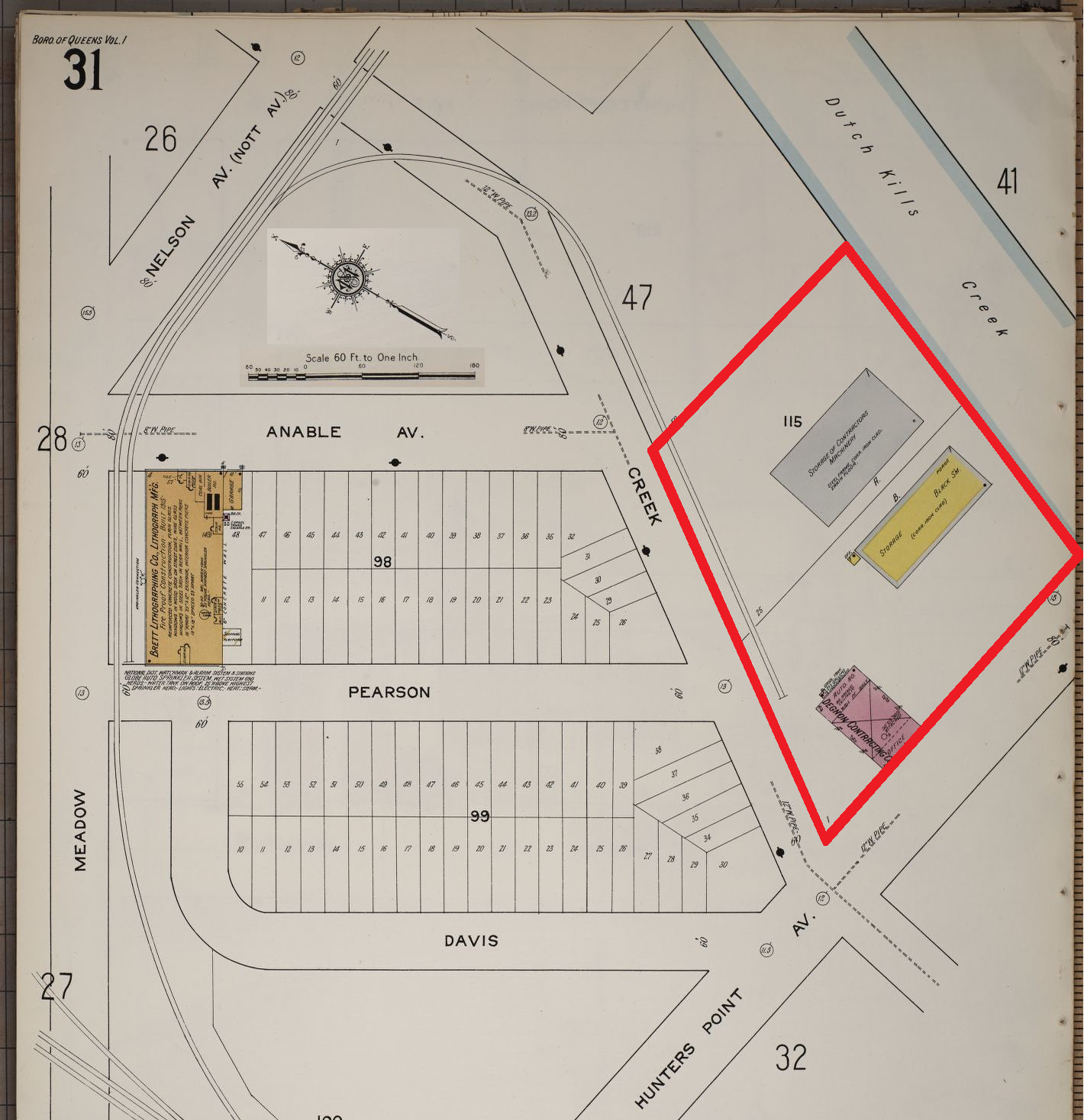 Possible location of Degnon Field (tract enclosed by red lines). The top of the map is northeast. The red building in the southwest corner of the tract is an office of the Degnon Contracting Company. Sanborn Fire Insurance from Queens, Queens County, New York, 1915, Vol. 1, Sheet 31. From the Library of Congress.
Possible location of Degnon Field (tract enclosed by red lines). The top of the map is northeast. The red building in the southwest corner of the tract is an office of the Degnon Contracting Company. Sanborn Fire Insurance from Queens, Queens County, New York, 1915, Vol. 1, Sheet 31. From the Library of Congress.
Degnon Field had a capacity of 4000. When Walter Ancker pitched against the cracks of Queensboro, 10,000 people packed the grounds, overflowing the grandstands to fill all of the foul territory and part of the playing field. It was the largest crowd ever to witness a baseball game in Queens County. The assembled masses, described as ‘a throng of miniature world series proportions,’ saw Ancker strike out 16, give up seven hits, walk three, and hit two batters to record a 6-3 win.
Ancker was back in Bergen County four days later. For the Columbus Day game, Ancker turned coat and joined the Indians of the Oritani Field Club, Tenafly’s rival and the class of Bergen County baseball. Their opponents: Ridgefield Park, with George Lowe on the mound. Viewed through the screenplay-conscious prose of the writer, it is obvious that Ancker, having proven his place in this semi-profession the previous Sunday, gritted his teeth and joined the hated Indians to Settle a Score with Jack Corbett, as we cast George Lowe in the role of Naively Pleasant Proxy.
Lowe, the bona fide professional whose major league career would total two innings of relief for the Cincinnati Reds in 1920, was an easy target for the Indians. He struck out nine but surrendered 12 hits, walked one, and made a wild pitch. Ancker struck out 10, gave up five hits and three walks, and went home to Closter with a 5-2 win.
Ridgefield Park’s two runs came in the fourth inning. With runners on first and second, the Ridgefield Park batter tapped one back to Ancker. He fielded the ball and threw to third base for the force out, but his toss went wide. Oritani Field featured a veritable cow pasture of foul territory on the third base side, and by the time someone chased down the ball, the runners on first and second had scored. The batter was nailed at third as he tried to milk Ancker’s throwing error for one base too many. Once again, Ancker was undone — though not fatally this time — by a ball hit back to the mound.
A recurring theme in the Walter Ancker Story is his inability to field his position. He could catch the ball, but the result after that was anyone’s guess. He might throw to the wrong base; he might throw wildly to the correct base; he might not throw the ball at all. It didn’t help that every time a batter returned the ball to the mound, Ancker saw only the sarcastically laughing face of Jack Corbett bounding straight towards him.
Two days after his win against Ridgefield Park, Ancker took the mound for the Degnon Grays in his fourth start against the Lincoln Giants. He lost the eight-inning game 7-11. Ancker was capable of putting in the work. He pitched three complete games — 26 innings — during the week of October 8, compiling a 2-1 record.
The following Saturday, with a full week of rest in his pocket, Ancker and the Grays took on the Queensboro All Leaguers, another amalgam of minor leaguers home from their disparate wars. The Grays managed only a single run, but that was all that was required. Ancker pitched a perfect game: no runner reached first base. No hits, walks, errors, or hit batters. He struck out 20 of the All Leaguers. ‘It was the best brand of pitching ever seen at Degnon Field,’ the Brooklyn Standard Union enthused.
Anker again toed the slab for the Degnon Grays the day after pitching his perfect game, this time against the Springfield Independents. The Grays and their bitter rivals from the Springfield neighborhood (it was not named Springfield Gardens until 1927) had agreed to play a best-of-three series to determine the championship of Queens. Springfield took the first game, played on October 15. At that point, Springfield’s management decided that the question of which team was best had been answered, and they canceled the remainder of the series. But the Springfield players agreed to play two more games on their own hook, under the banner of the Independents.
Ancker was unable to recapture the previous day’s greatness. He gave up five runs and 11 hits, struck out six, walked four, hit a batter, and made a wild pitch. The game was called for darkness after eight innings, with the score tied 5-5.
Walter Ancker and the Degnon Grays closed out their 1916 season seven days later with a final game against the Independents. Ancker almost replicated the previous week’s no hitter. The leadoff batter blasted Ancker’s first pitch over the fence for a home run, but that was the Independents’ last hit. The Grays won 9-1, with Ancker striking out eight and walking three.
It had been an incredible month for Ancker: the win against the Queensboro All Stars when he struck out 16 in front of 10,000 fans; the win against Asheville’s George Lowe and Ridgefield Park; the perfect game that included 20 strikeouts; the one-hitter against Springfield. Thirty-seven years later, when Walter Ancker viewed his life in reverse just before he died of a ruptured duodenal ulcer, he probably chose October 1916 as the film’s highlight.
Ancker had rehabilitated himself and proved to himself that he was a pitcher. Asheville was a memory not worth revisiting.
—-
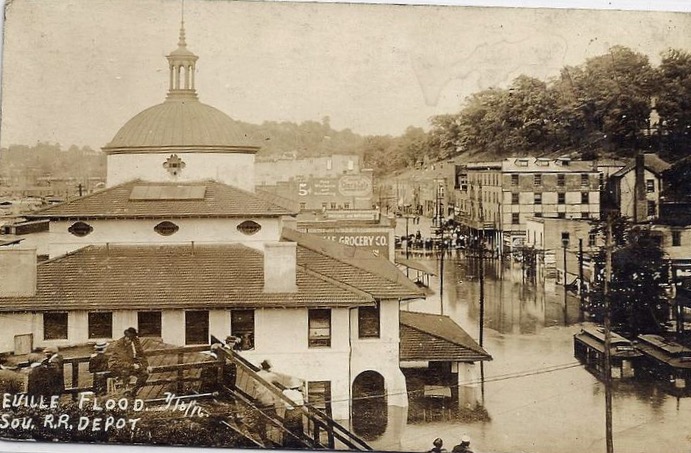 Southern Railway depot in Asheville, North Carolina, following the flood of 1916. Swamped streetcars are visible on the right. From the City of Asheville.
Southern Railway depot in Asheville, North Carolina, following the flood of 1916. Swamped streetcars are visible on the right. From the City of Asheville.
The last North Carolina League batter Ancker faced was Charlotte catcher Dick Manchester. A month after Ancker’s departure, Manchester attacked umpire Ed Lauzon with his catcher’s mask, striking him three times and opening a large gash under Lauzon’s eye. Manchester was arrested and charged with assault with a deadly weapon. The league levied a $40 fine and a five-game suspension.
In mid-July, a pair of tropical depressions, one from the Gulf of Mexico and one from the Atlantic, converged over North Carolina and dumped their baggage into the French Broad Basin. The waters poured down the valleys, breaking dams and sweeping away bridges and railroad trestles. The flood resulted in 80 deaths, two within Asheville. The town was completely cut off, with trains full of passengers stranded in the mountains.
A story emerged decades later that Jack Corbett led his team on a grueling 20-mile hike to the nearest functioning rail line to reach their next game. That was undoubtedly a tall tale invented by Corbett. Contemporary articles placed Corbett and the Tourists in Asheville, practicing and repairing Oates Park. Meanwhile, the management of the Charlotte Hornets, with whom the Tourists were scheduled to play a series, demanded that the North Carolina League president force the Tourists to forfeit the games and hand over a fee for non-appearance.
In August, while playing a series in Durham, Corbett took issue with a base-running decision made by his catcher, a fellow named Novack. As Novack approached the dugout at the close of the inning, Corbett emerged and attacked him. ‘The two players clinched and in an instant Novack, who is stocky and powerful, was on top of Corbett choking his manager,’ the Citizen-Times reported. A police sergeant emerged from the stands and arrested the fighters.
Both Corbett and Novack were charged with assault and released. The judge ordered them to appear the next morning to answer the charges. Novack did not show up, having left in the night ‘for an unknown destination,’ and Corbett was declared not guilty. Corbett handed the already-departed Novack his unconditional release, but not before fining him 19 days of pay, equivalent to the back wages owed to the fugitive.
The last game of a minor league season was often a day for fun and theatrics. In the final 1916 regular-season game played at Oates Park, the Tourists and the Winston-Salem Twins romped through an entire nine-inning game in only 31 minutes, the fastest professional baseball game ever played.
The Asheville Tourists won the first half of the North Carolina League’s split season. The Charlotte Hornets took the second session, then defeated the Tourists in a best-of-seven playoff series.
Corbett left Asheville following the 1916 season and was named the player-manager of the Columbia Comers. After the war, Corbett became a serial entrepreneur. He joined S.A. Lynch in a motion picture distribution business. He was part-owner of the Atlanta Crackers of the Class A Southern Association. He ran a company that made seats for grandstands and owned a firm that manufactured baseball bats. He bought an interest in the Jersey City Skeeters of the Class AA International League and relocated the team to Syracuse, where the club became the Chiefs. He was, briefly, president of the San Diego Padres (then a minor league franchise) and worked in the Boston Red Sox organization.
In 1948 Corbett bought the El Paso Texans of the Class C Arizona-Texas League. Following the 1949 season, the Texans’ player-manager, Syd Cohen, learned that he had been fired when he ran into Corbett on the street and Corbett asked him, ‘Where are you going to manage next year?’
Two years after purchasing the Texans, Corbett took the first step in what would become a long-running feud with organized baseball when he signed Ventura Morales, an outfielder on the Mexican League’s reserved list.
Clubs from the Mexican League and the United States major and minor leagues staged a series of cross-border raids on each other’s talent pools in the years following World War II. Many players chased the money, going to whatever side of the river paid the best. To control wages and protect their fiefdoms, Mexican League president Eduardo Quijano, US major league baseball commissioner Happy Chandler, and George Trautman, president of the US minor league professional association, reached a verbal agreement to respect the reserved lists of all parties. A league’s reserved list comprised all active and inactive players who had signed a contract but had not been granted their unconditional release.
Trautman refused to approve Corbett’s contract with Morales. Nevertheless, the outfielder appeared in the Texans’ opening day lineup. Trautman fined the Texans $1000 and handed Corbett an indefinite suspension.
Trautman eventually lifted the fine and suspension, but Corbett filed a lawsuit against Chandler, Trautman, and various other entities and individuals. He claimed that the reserve clause violated antitrust laws and that Chandler and Trautman had no authority to represent the teams in an agreement with the Mexican League. Corbett sought $300,000 in damages. The suit went all the way to the US Supreme Court, where Corbett lost in 1953.
Sensing that baseball was in decline while football was gaining popularity, in the late 1950’s Corbett organized the International Football League, intended to bring professional football to cities shunned by the NFL. The new combination never got off the ground, and the upstart American Football League usurped some of the IFL’s intended locations. When the AFL filed a $10 million antitrust suit against the NFL, Corbett, on the theory that what’s good for the goose is good for the gander, announced that he would sue the AFL for $11.2 million. ‘I don’t think the AFL has grounds for a suit against the NFL,’ Corbett said. ‘But if it’s entitled to some damages, so am I.’ The outcome of the planned litigation is not clear.
Jack Corbett had an admirable capacity to hold a grudge. Years after his initial suit against organized baseball had ended, he was still bombarding George Trautman with telegrams and letters. In 1964 Corbet again sued major and minor league baseball, among others, for $2.5 million, claiming that they had conspired to blackball him from baseball.
Although Corbett never made it to the major leagues and was allegedly blackballed from the game, he is now a fixture in every major league ballpark. Dissatisfied with the sandbag base typically used at first, second, and third, Corbett designed and patented a rubber-and-fiberglass base mounted on a metal tube. The tube was inserted into a sleeve permanently set in the ground, allowing the base to be precisely positioned and to be removed after each game. The Jack Corbett Hollywood Base was adopted as the standard base of the American and National leagues. Today, every major league base bears the name Jack Corbett.
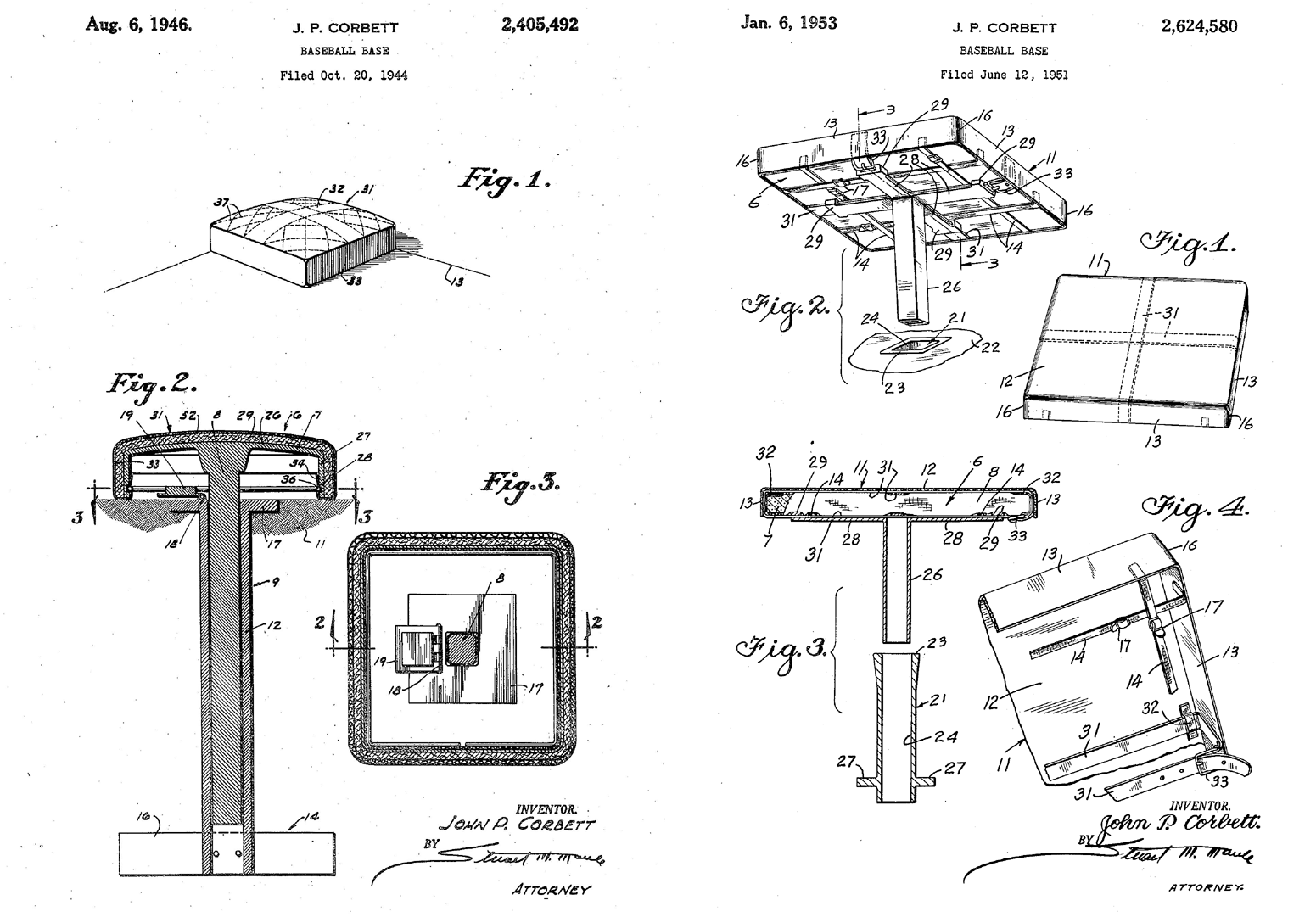 Patent filings for the J.P. Corbett Baseball Base. From Keyman Collectibles.
Patent filings for the J.P. Corbett Baseball Base. From Keyman Collectibles.
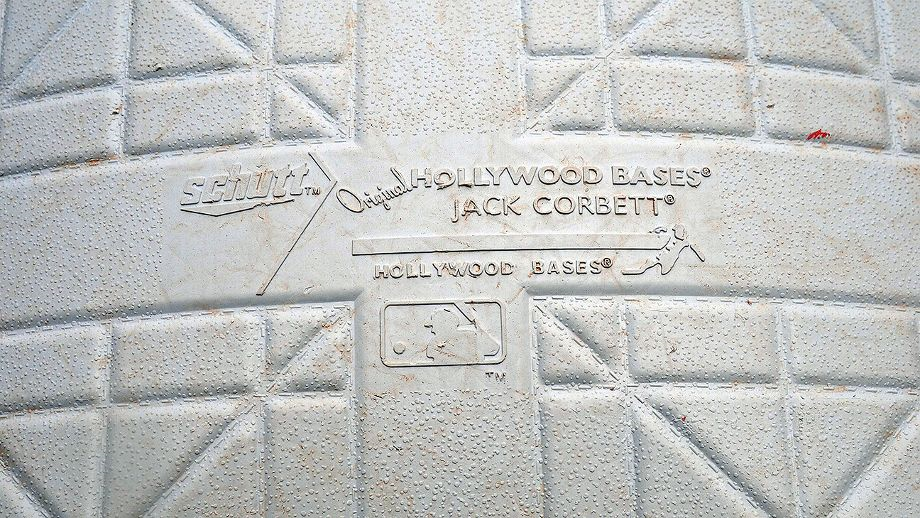 Logo on the Jack Corbett Hollywood Base, manufactured by Schutt Sports and used by Major League Baseball. From ESPN.
Logo on the Jack Corbett Hollywood Base, manufactured by Schutt Sports and used by Major League Baseball. From ESPN.
In Thomas Wolfe’s The Web and the Rock, a black-haired baseball player named Nebraska Crane uses his bat to bludgeon a red-haired boy, breaking his arm. The author never revealed the character’s real-world inspiration. But Jack Corbett, who lived in the boarding house run by Wolfe’s mother, happily took credit for the role.
Jack Corbett died in 1973 at the age of 86. The Dayton Journal Herald, with unintended humor, announced his passing with the headline Corbett dies, sues baseball.
